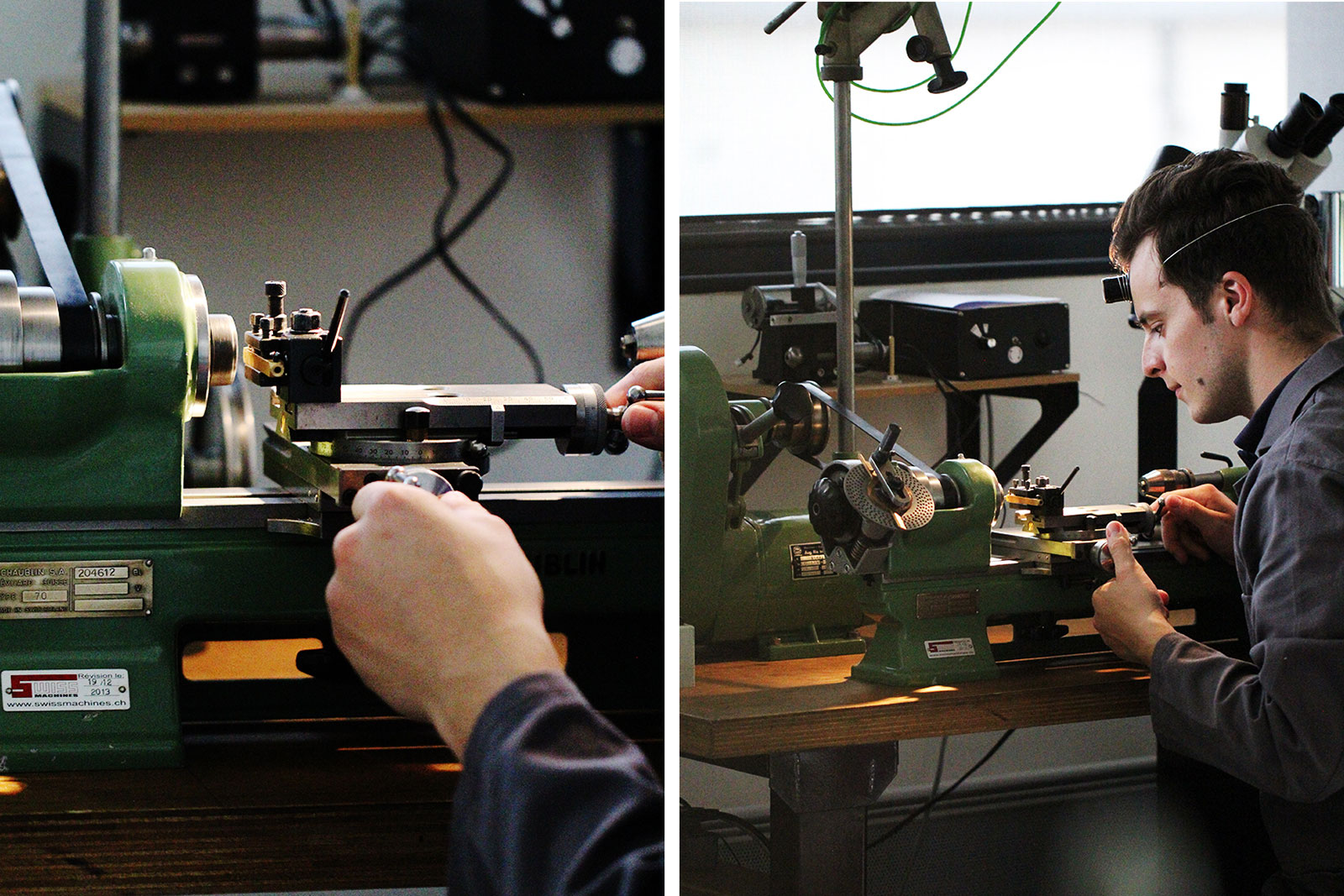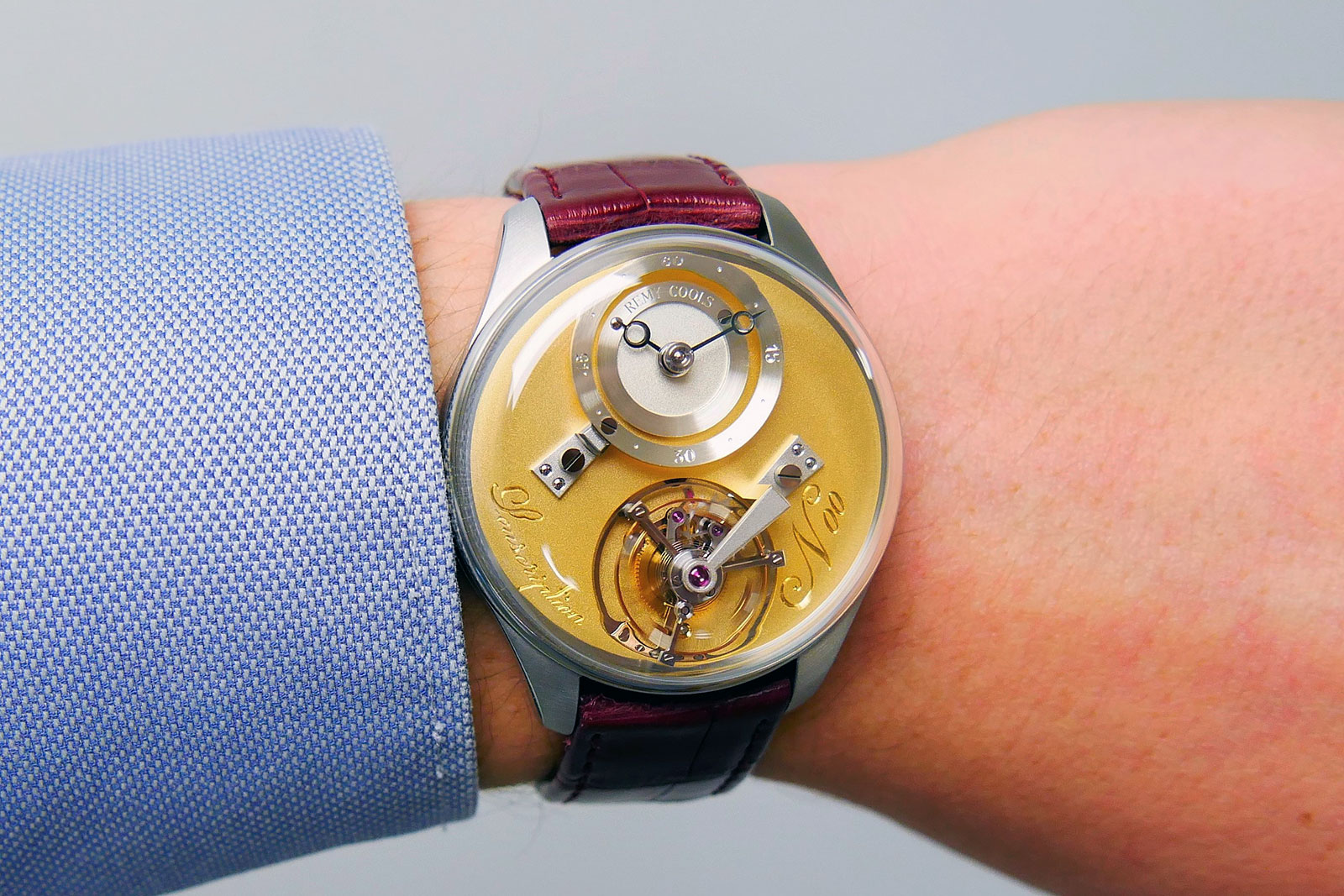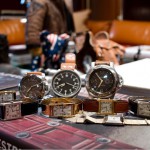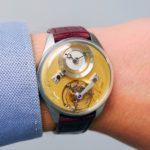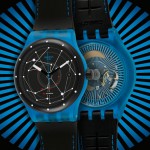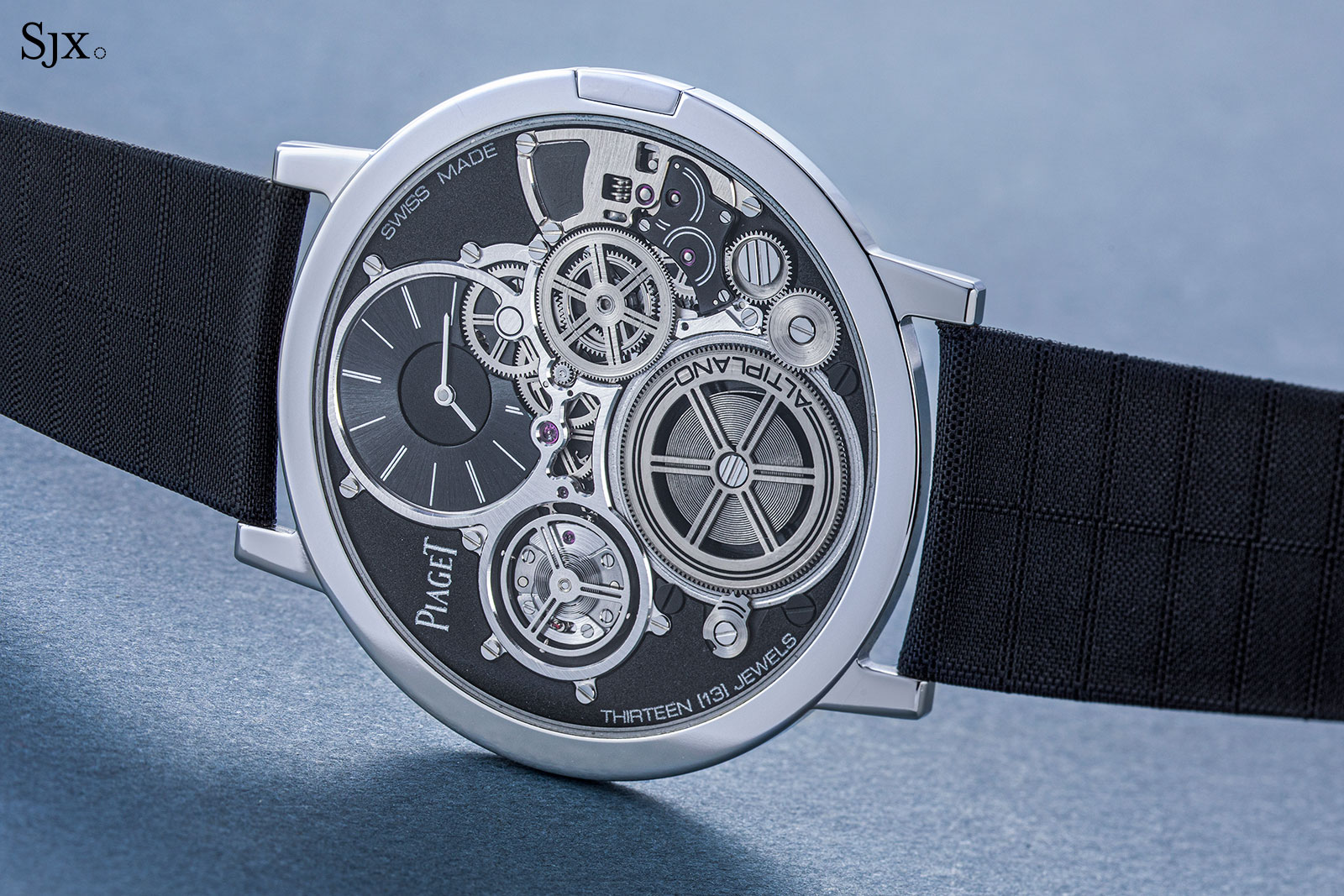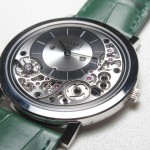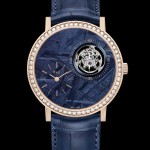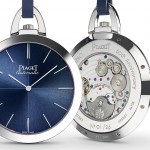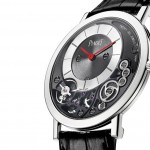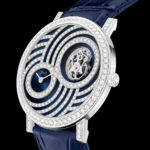A relentless pursuit of diminishing returns seems to be the norm in the world of high-end watchmaking. Better finishing, lightness, longer power reserve, or chronometric performance, refined and enhanced to the nth degree – there is always something to improve, but by tinier and tinier margins.
Brands and watchmakers, in turn, often develop a specific niche, trying to best each other with ever-smaller improvements. In the niche of ultra-thin watches, there are only a handful of serious players.
Piaget is one such player. The brand’s forte is thickness, or rather, thinness – Piaget has held the record for the thinnest production watch on multiple occasions, with only a handful of rivals able to best its various records. And now it’s the reigning champ once again with the Altiplano Ultimate Concept (AUC).
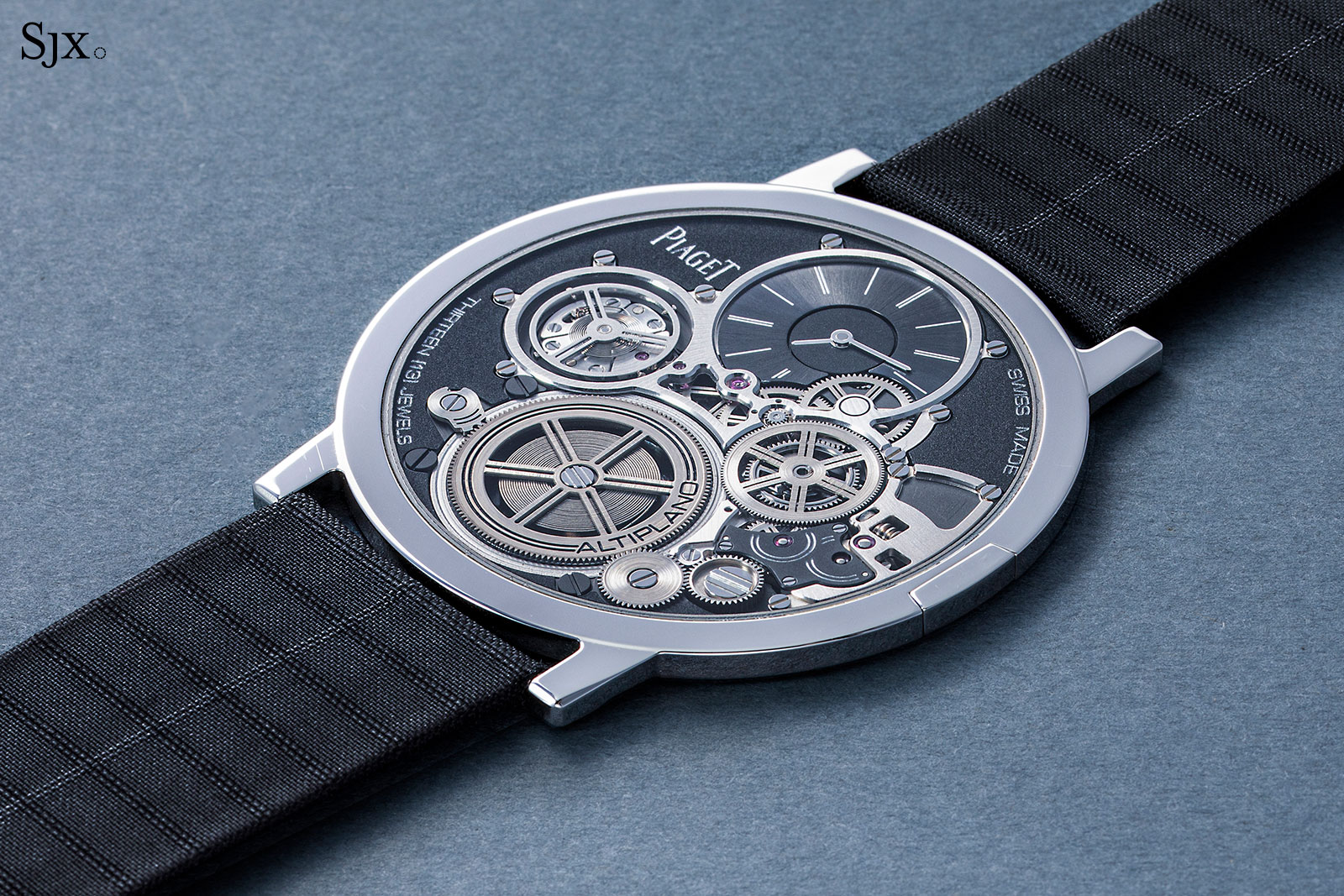
Just 2 mm high in its entirety, the AUC is so thin it looks almost like an optical illusion in photos – and a prop in real life. But it is a perfectly functional – and water-resistant – mechanical wristwatch.
So the question is, how did Piaget do it? And of course, do the diminishing marginal gains justify the retail price of approximately 400,000 Swiss francs?
Altiplano evolution
Prior to the AUC, Piaget’s best-known attempt at the crown was the Altiplano 900P. Released in 2013, the Altiplano 900P stands just 3.65 mm high.
It held the record of the thinnest mechanical watch on the market until 2015, when the title taken by Piaget’s sister brand, Jaeger-LeCoultre; both brands are owned by Swiss group Richemont. That year JLC debuted the Master Ultra-Thin Squelette, beating Piaget’s record by a literal hair’s breadth – 0.05 mm.
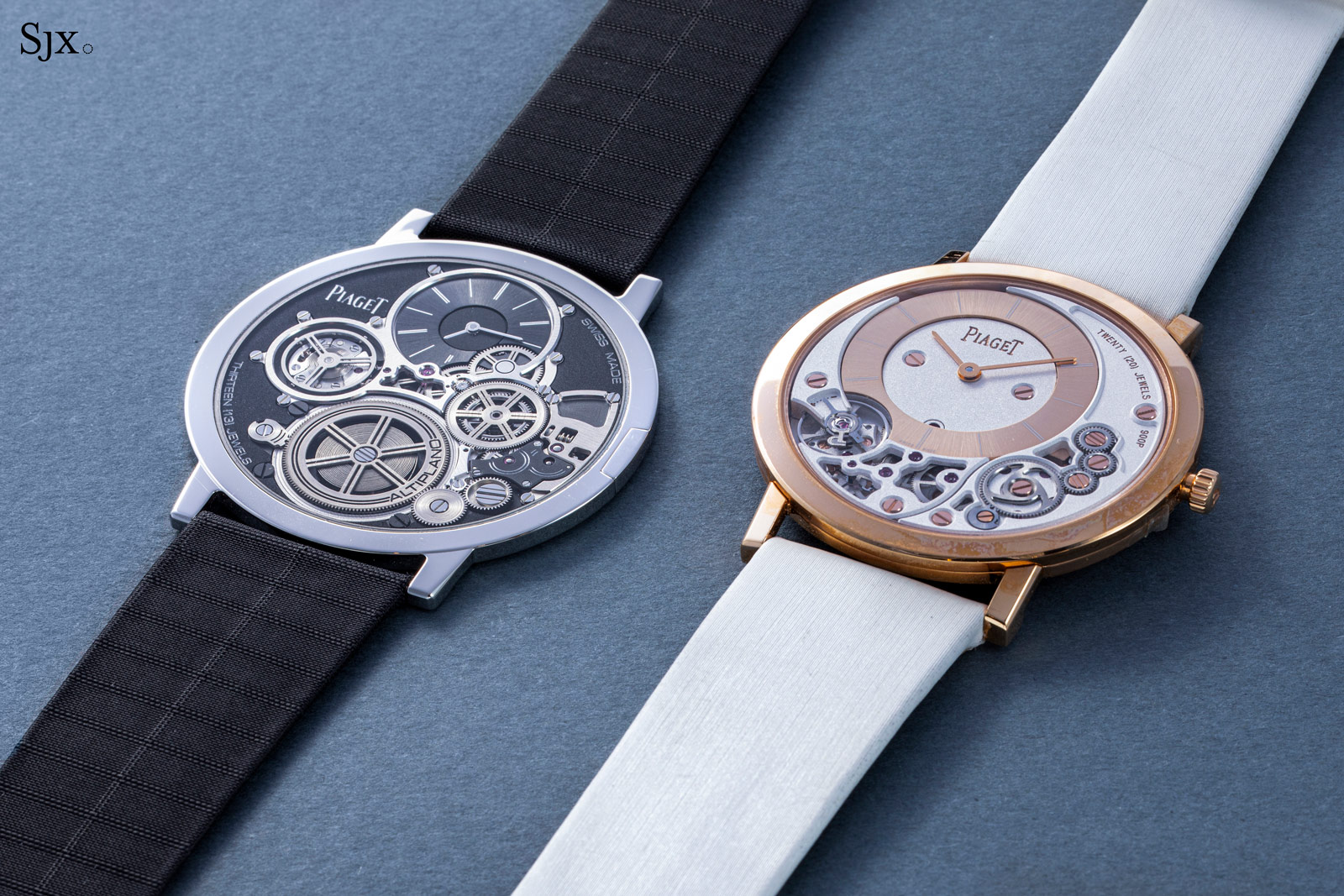
The AUC (left), and Altiplano 900P
Fast forward three years and Piaget reclaimed the throne when the AUC was born. The watch set the record by a generous margin – its case is a mind-boggling 2 mm.
For comparison, 20 sheets of standard printer paper are also 2 mm high, which is only slightly thicker than a U.S. penny. In fact, the AUC is thinner than most watch straps, so thin it needed a special strap designed specifically for it.
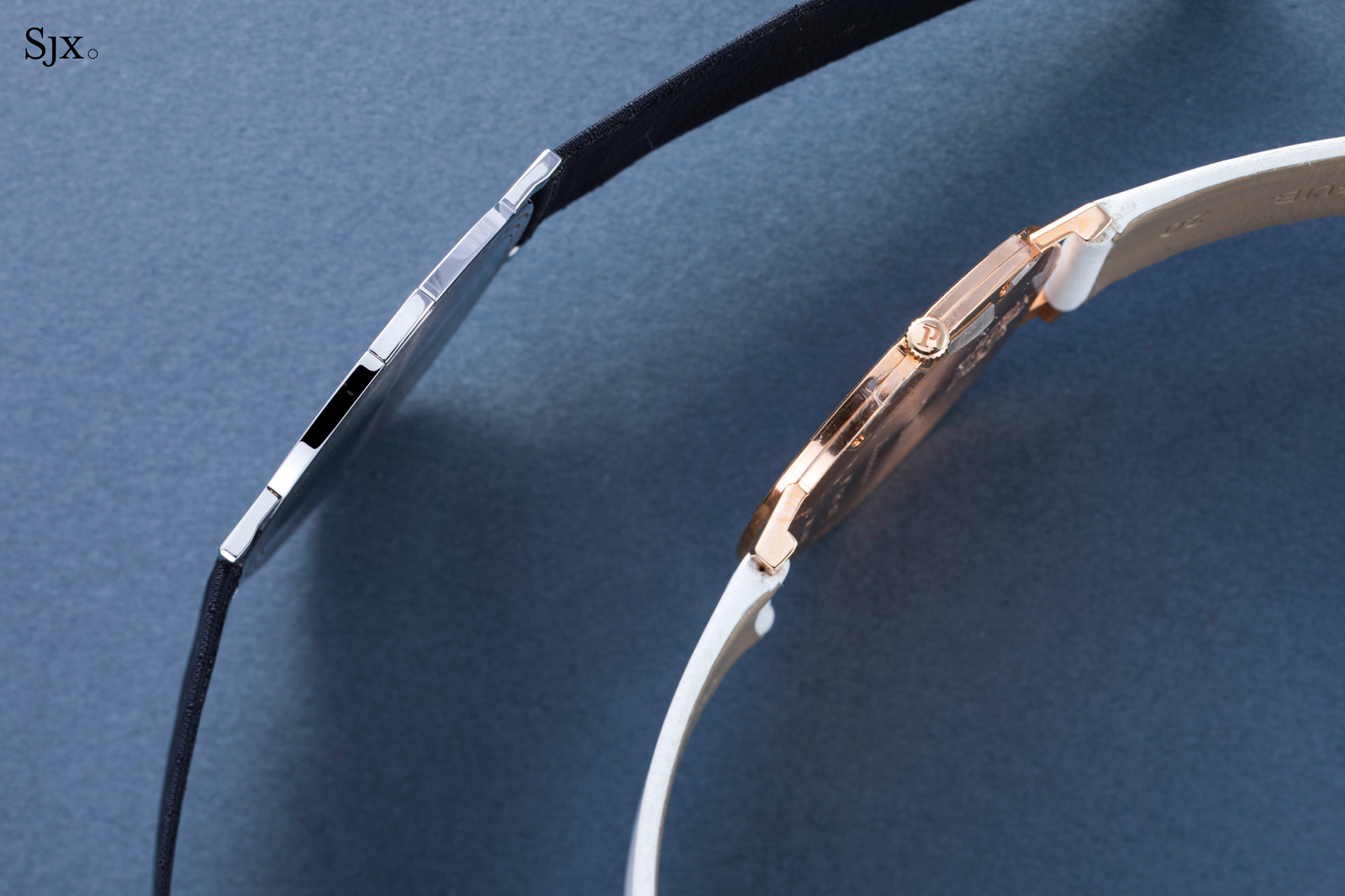
The AUC at 2 mm (left), and the Altiplano 900P at 3.65 mm
From concept to reality
First, it has to be noted that the unveil in 2018 was of a concept watch – the example presented was not yet a commercially viable product.
The concept watch was the initial realisation of an audacious idea, but still required testing, refinement, and perfecting the production methods, such it could eventually be serially produced with consistency.
And perhaps more importantly – as is often the case with concept watches, the AUC was no doubt developed with the intention of allowing its innovations to subsequently trickle down to more accessible timepieces.
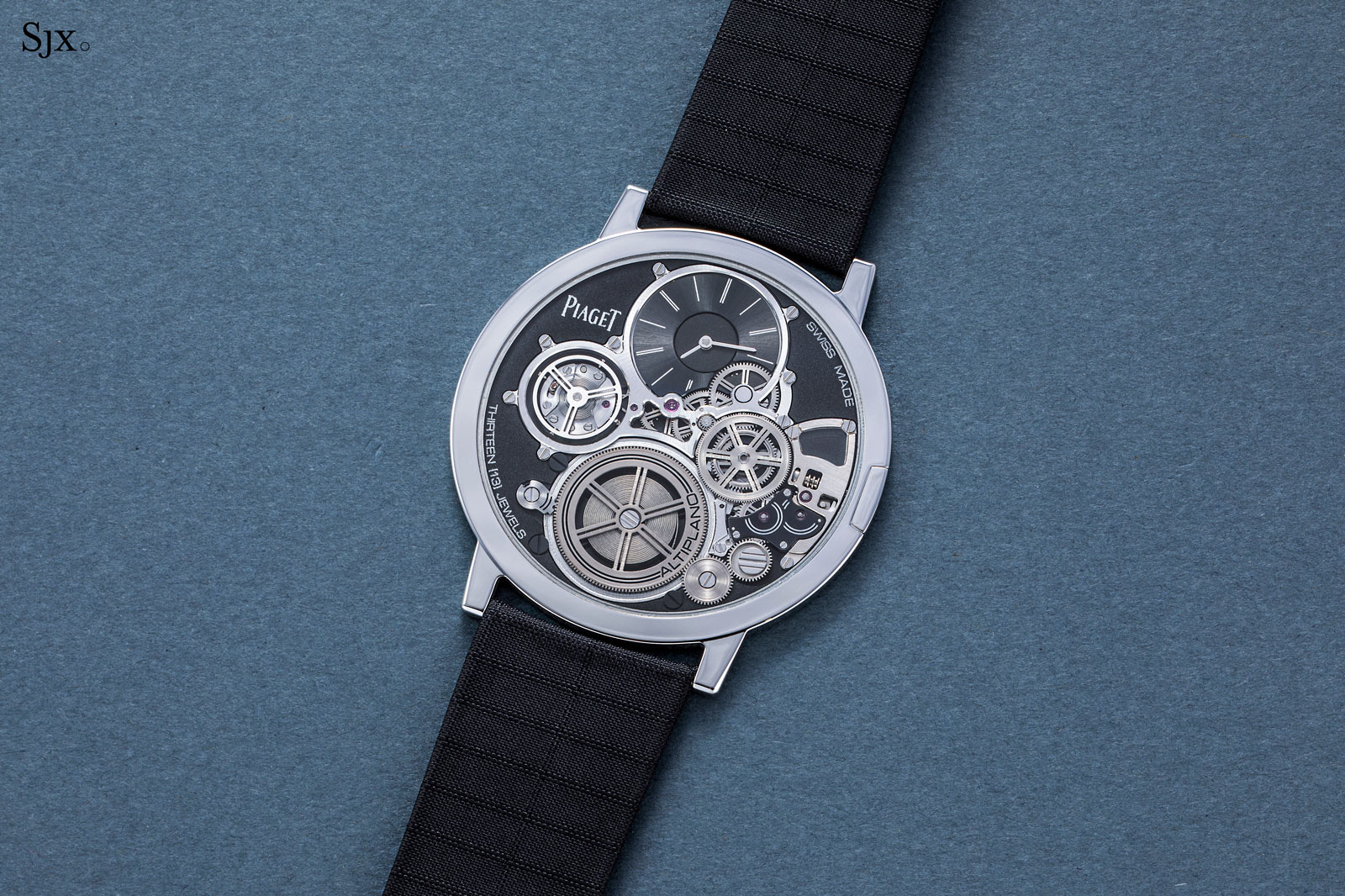
The AUC project started six years ago as a blank slate with only one goal: push the limits of thinness, but with two major constraints that made it all the more of a challenge.
One was practicality – the AUC had to function and wear like an ordinary watch as far as possible. Amongst other things, that explains the more-than-sufficient 20 m water resistance rating of the watch.
The second constraint lay in the materials: the movement could only be made of traditional materials. That immediately ruled out high-tech materials, like silicon or carbon-nanotube composites, which would have been an easy route to the finish line.
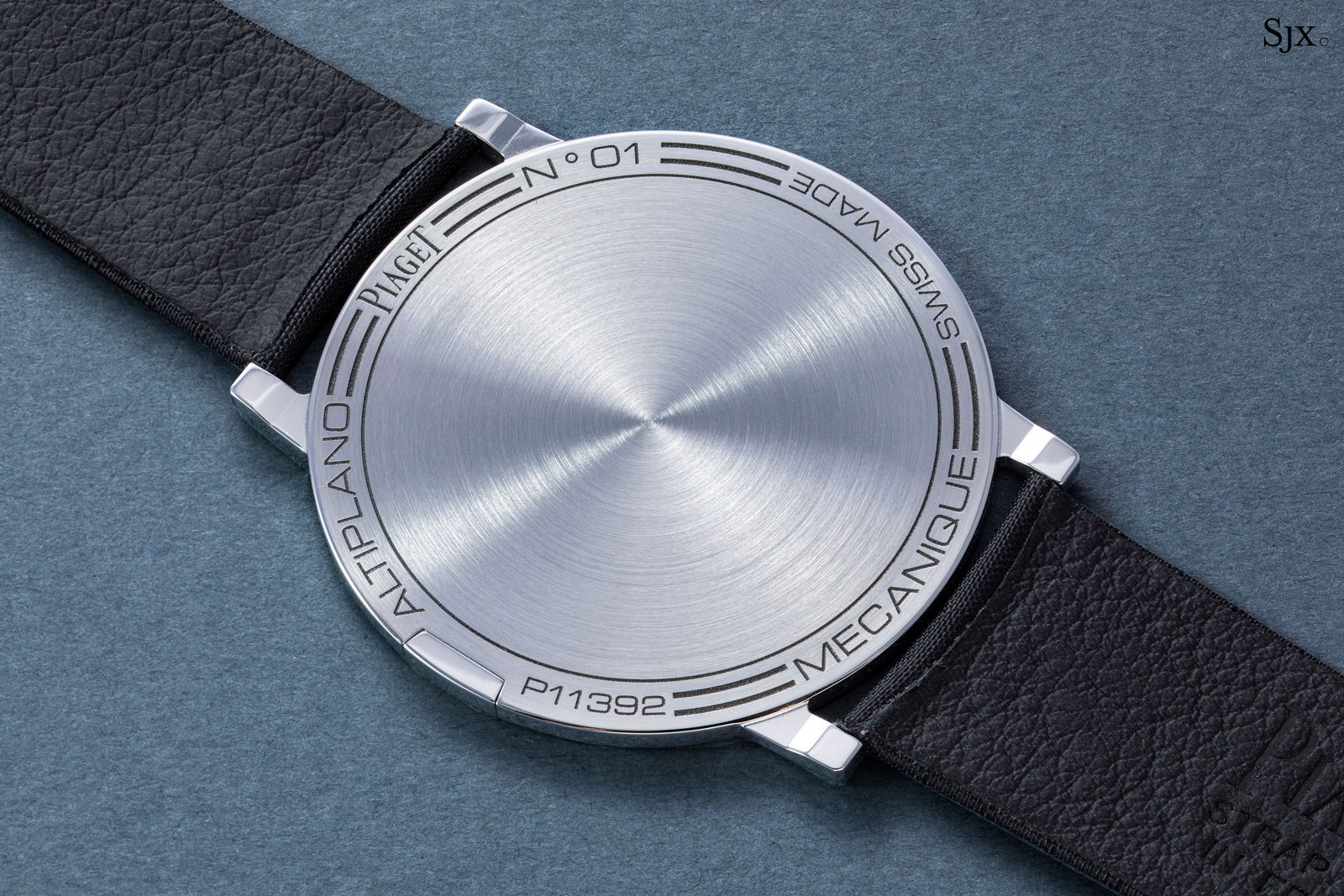
A case for the ultra-thin
Because the watch case is so thin, it will flex when bent or twisted – or even worn too tight on the wrist – if it had been made from conventional metals like gold. While the total height of the case is 2 mm, some internal sections of the case are machined to under 0.2 mm – the equivalent of barely two pieces of paper.
As a result, an exceptionally rigid metal was required for the case. The answer lay with M64BC, a cobalt alloy that’s almost a third chromium plus a significant amount of molybdenum.
Primarily used for surgical implants – which need to be thin but extremely strong – the alloy is also hypoallergenic like titanium, meaning it it doesn’t irritate the skin (certain gold alloys, for instance, can cause allergic reactions for a small number of people).
More importantly, unlike majority of cases that utilise novel material as a matter of style, the cobalt alloy in the AUC is a matter of necessity.
The stiffness of the alloy made it ideal for the case. Its properties allowed for a relatively strong case, despite the thinness – almost double the yield strength of typical stainless steel alloys. In fact, the case feels reassuringly robust and resistant to bending when handled, even with intentional force applied – a strange sensation given how delicate the wafer-thin case appears.
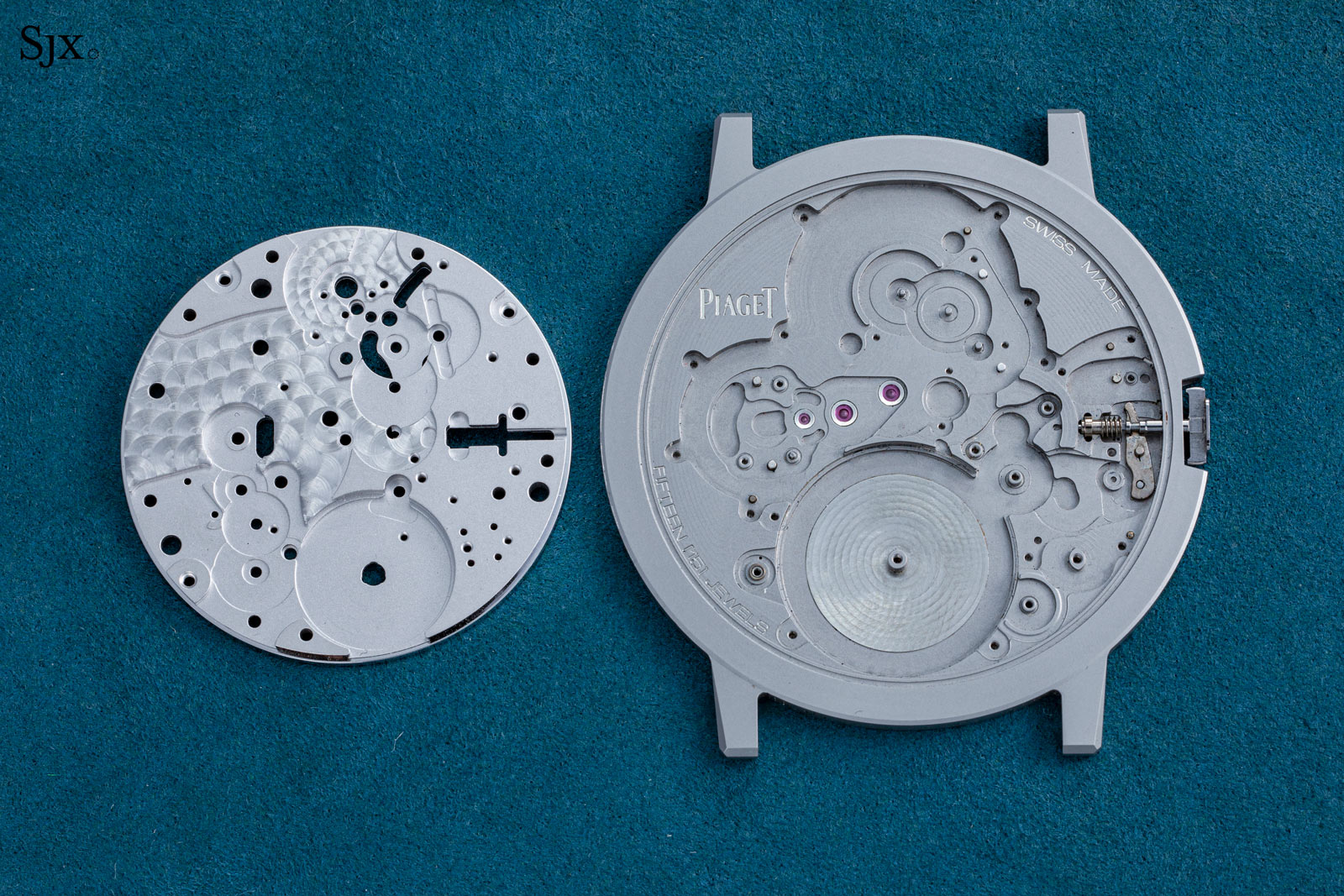
The main plate of a cal. 1208P (left), against the case of the AUC that incorporates the main plate
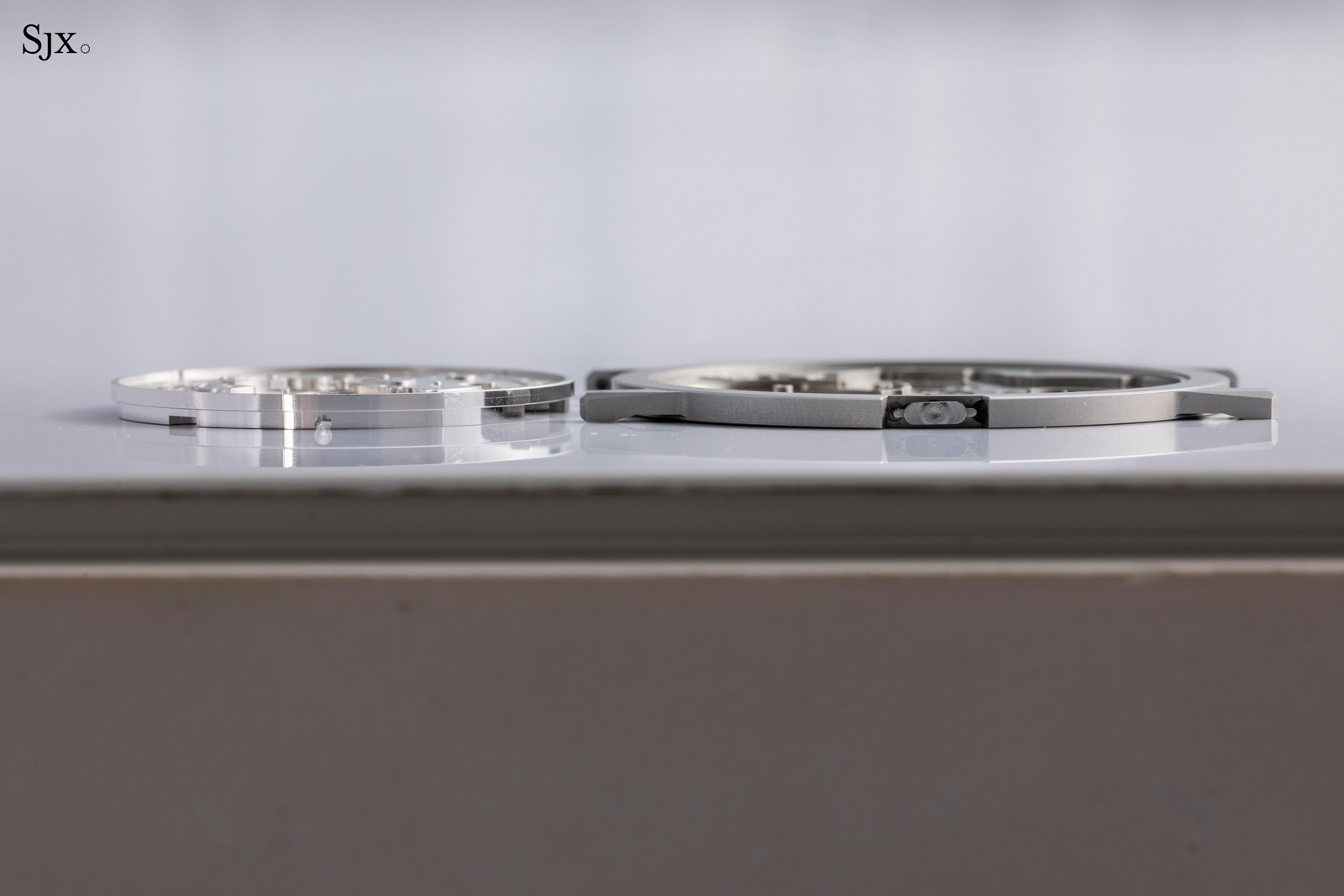
Notice how the entire AUC case (right) is thinner than the cal. 1208P main plate
Beyond its stiffness and strength,, however, the cobalt allot is also hard, an intrinsic drawback in case productions it is difficult to machine. While ordinary watch cases might not require the same tight tolerances as movement components, the case of the AUC is actually the base plate, which necessitates absolutely precise machining – especially for the holes and location of the pivots.
The case of the prototype was made in-house by Piaget at its manufacture in La Côte-aux-Fées, but then subcontracted to a specialist when the AUC made it into production. Notably, the specialist in question is a producer of movement components – and not a case maker – because the case is essentially a base plate, which means far narrower tolerances than an ordinary case. At the same time, the composition of the cobalt alloy was tweaked, so the production watches use a different, but related, cobalt alloy.
At a glance, it might seem that the definition of traditional materials was stretched to accommodate the case, since cobalt alloys are unusual in watches (in fact, this specific alloy is being used for the first time in watchmaking). But the case is still a metal alloy, instead of metal or carbon composites, making it quite conventional.
Thinning the movement
The most radical aspect of the watch – but also one that has a strong historical basis – is the movement. While entirely different from most mechanical watches, the AUC movement is an evolution of the original 900P in some ways.
Still, the 900P is comparatively orthodox in terms of construction: with the exception of the base plate integrated into the case, the 900P has a regular going train with pivots, an ordinary balance wheel-and-escapement setup, and a typical keyless works. The AUC had to revisit all these fundamental elements to achieve a slimness that exceeded the 900P.
A good starting point to understand the radical rethinking that made it possible is the mainspring, one of the largest components in a movement. Conventionally, a mainspring has to be supported on its pivots with a robust bridge to withstand the torque it supplies the going train. In some ultra-thin watches, the barrel is supported only on its bottom, facing the main plate, and is left “hanging” or “floating” on its top.
That is not possible in the AUC due to how thin the base plate is – installing the barrel pivot into the thin main plate will likely led to the torque of the mainspring causing plate to warp or shearing the pivot off.
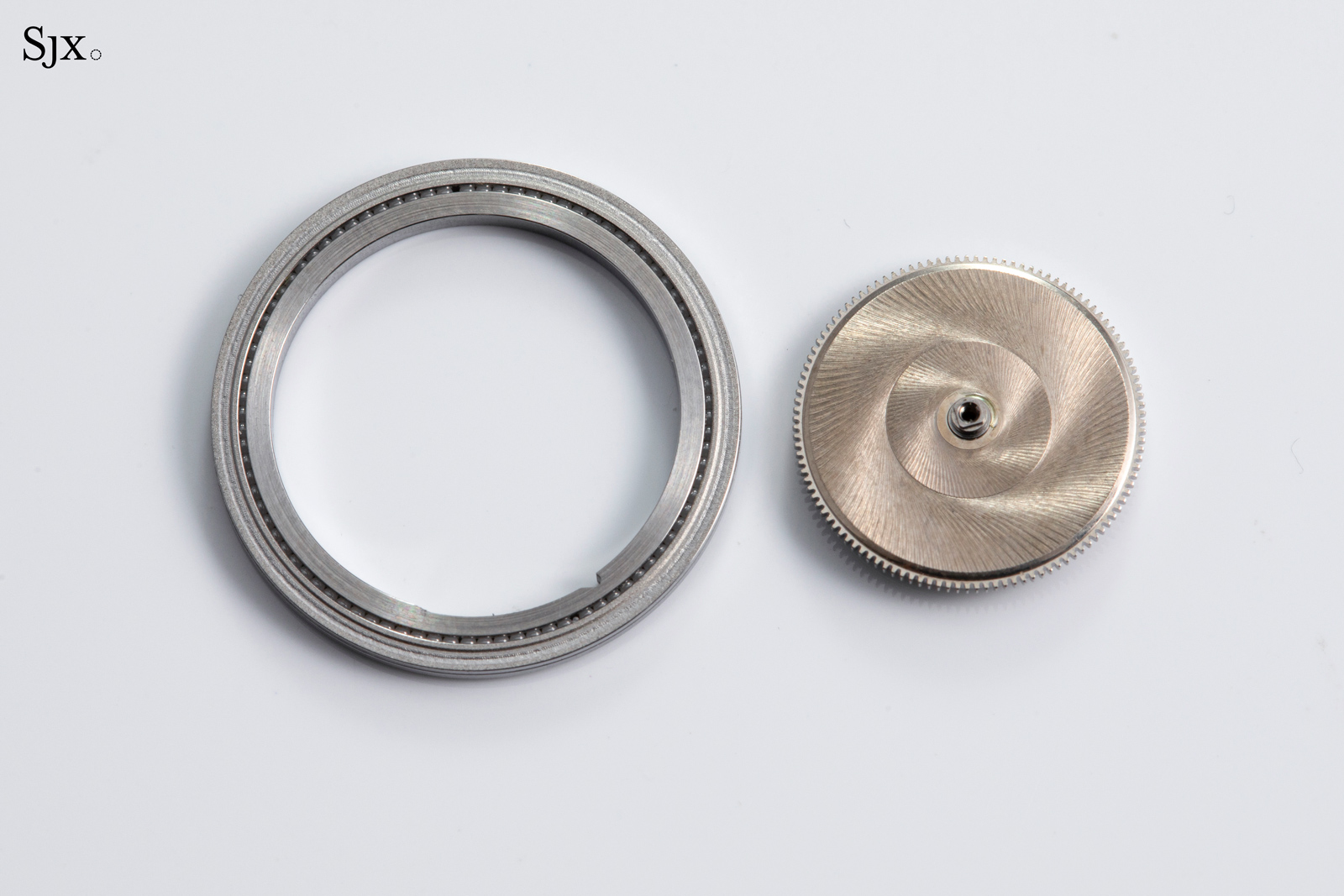
The open-barrel of the AUC (left), and a typical barrel from an ultra-thin Piaget movement
Thus, the AUC uses an unconventional open-barrel – rather than being fully supported by a central pivot, the barrel is secured on its periphery with ball bearings in a slew-ring configuration, much like a turntable. This is a more robust construction while preserving the overall thinness, since the barrel does not have to be sandwiched between bridges.
Also, because there’s no need for a robust central pivot, the barrel diameter can be made relatively large, thus still providing a respectable 40 hours of power reserve – in a movement as tall as a few sheets of paper.
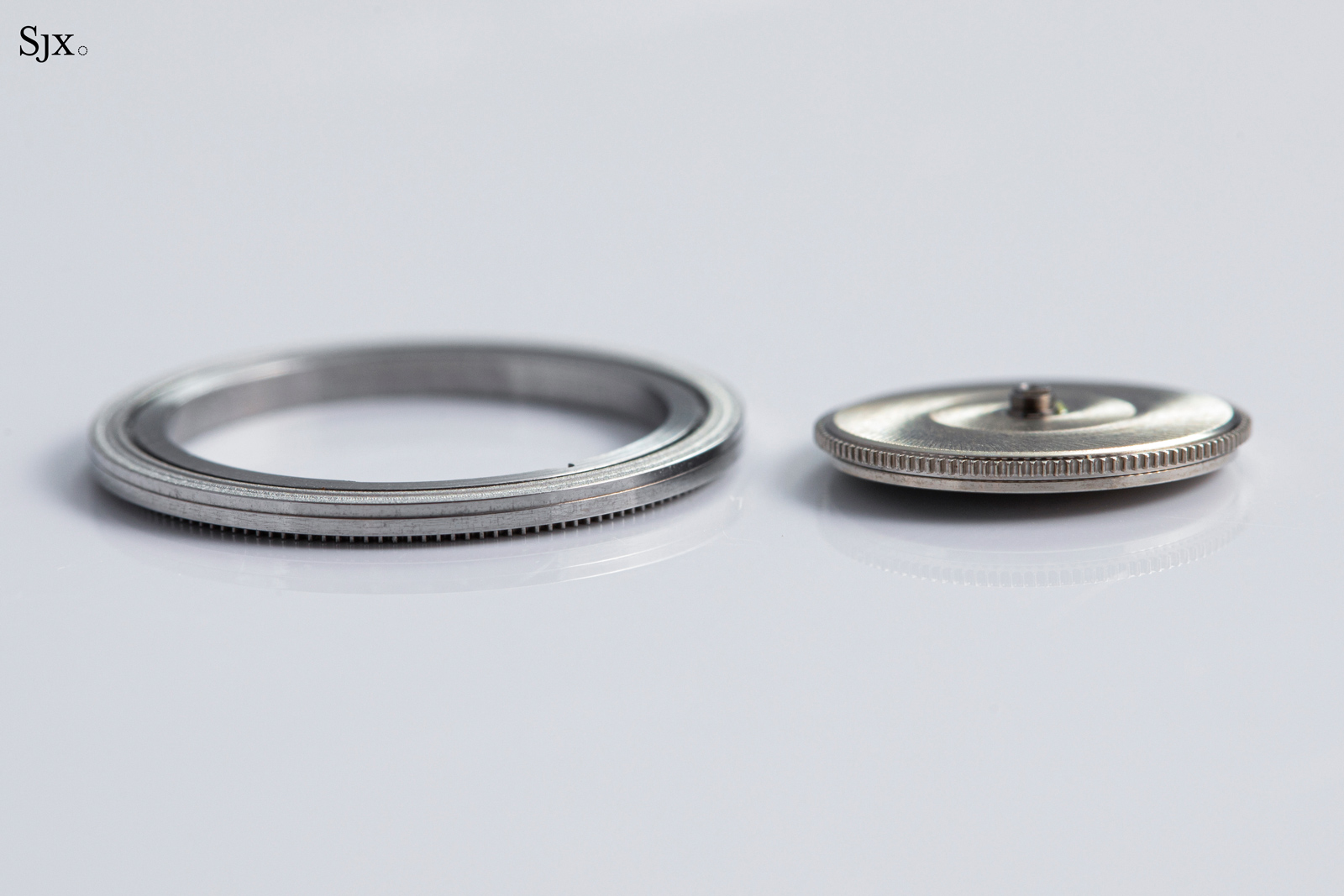
The AUC barrel (left) is a large, open ring
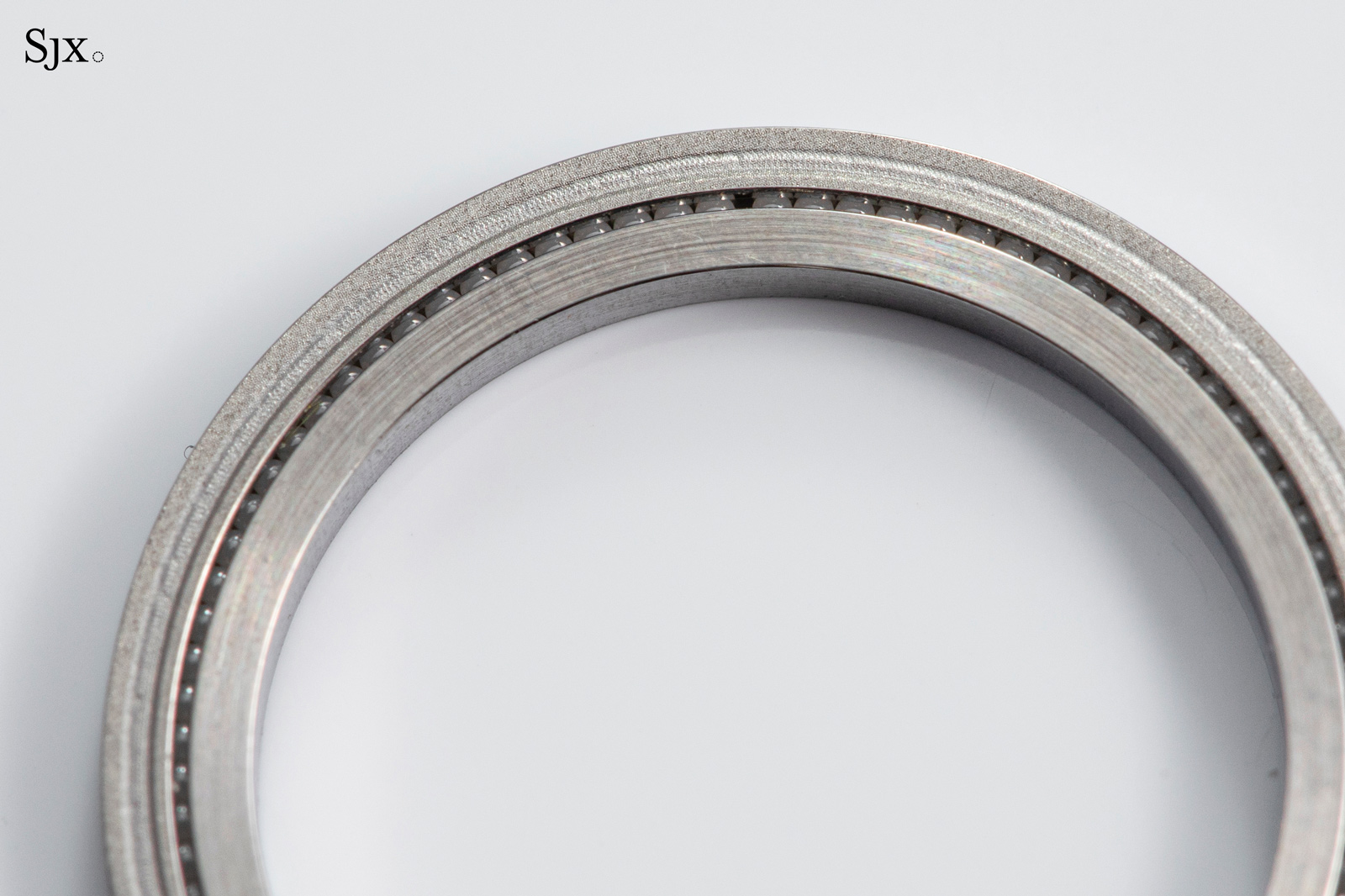
The AUC barrel is constructed with ball bearings, with an inner race holding the mainspring
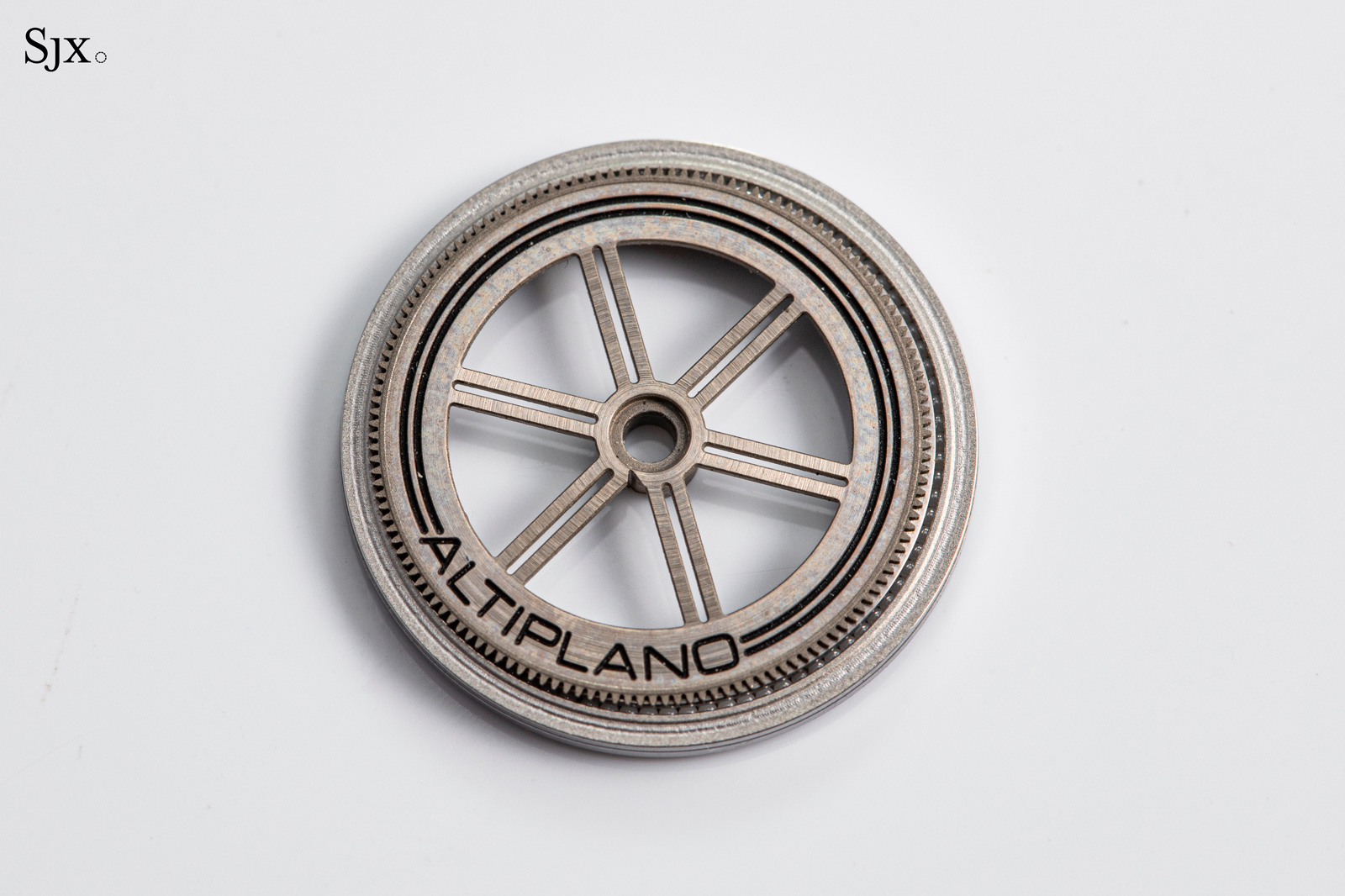
The barrel ratchet wheel sits on top of the open barrel, and fastens to the main plate via a screw in its centre
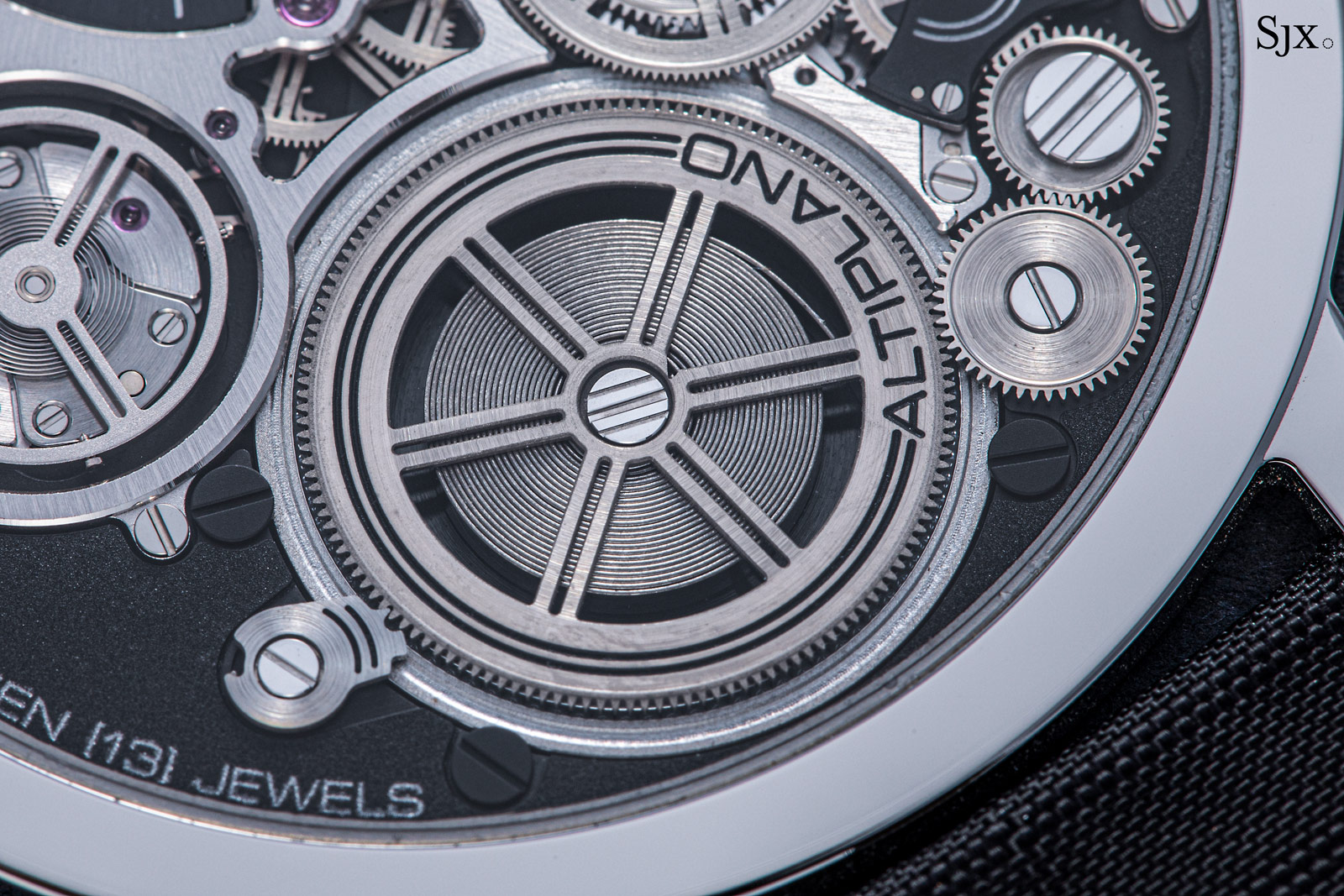
The fully-wound barrel of the AUC
While the barrel was entirely rethought, most of the going train components were preserved in a fairly conventional manner but made thinner, much thinner.
Case in point, the 900P has 0.2 mm-high wheels, but the AUC boasts wheels just 0.12 mm thick. Beyond overall thickness, the thinness of the wheels are also crucial in leaving a tiny-but-sufficient volume of vertical space for a dial to show the time.
The diminutive size of the parts result in an unusually high rejection rate. For instance, the smallest axle in any movement is that of the pallet fork, which is even smaller than usual in the AUC. Consequently, the rejection rate for the pallet fork pivot in the AUC was 60%, as compared to under 5% for the same component found in Piaget’s standard ultra-thin watches.
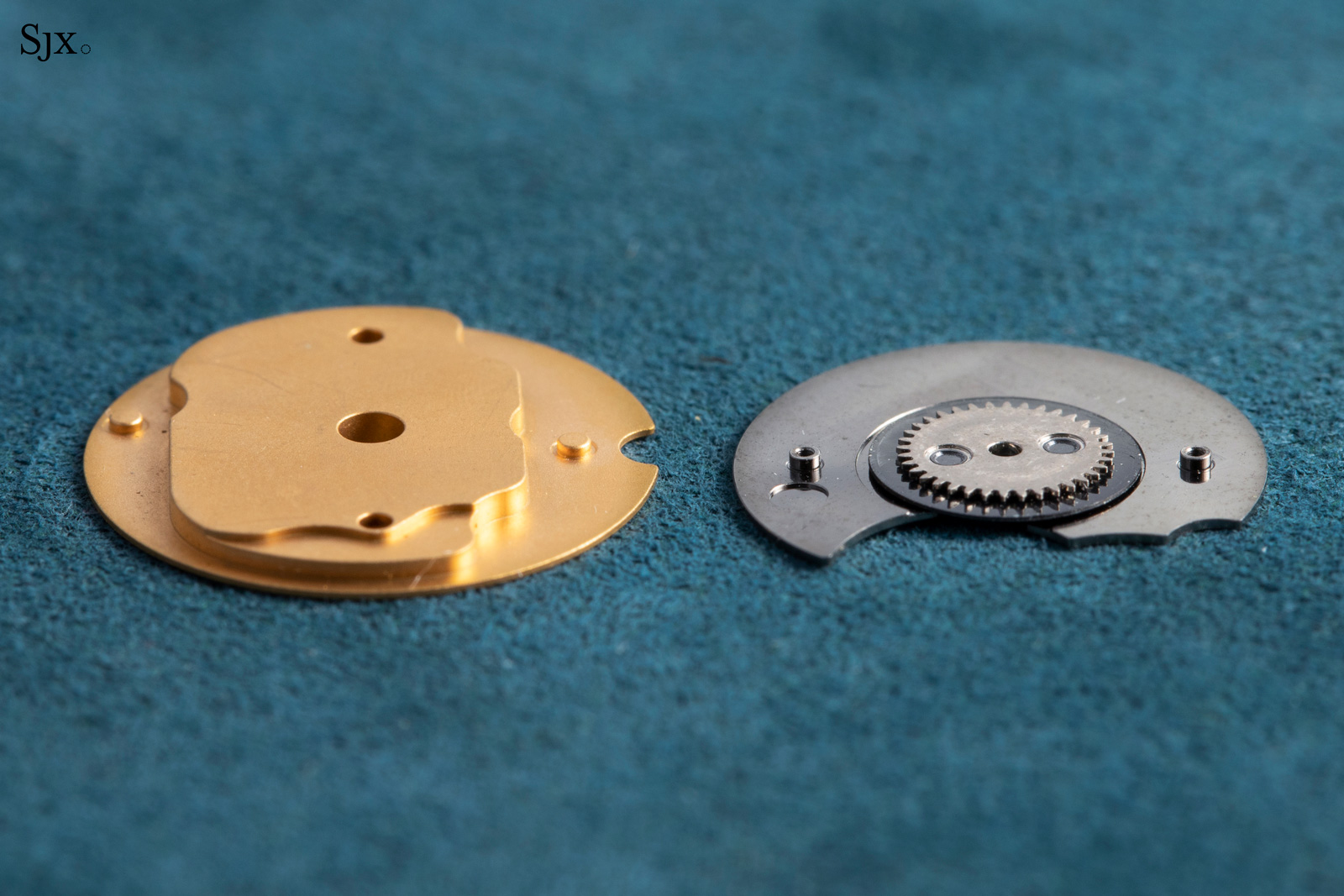
The underside of the dial of a 900/910P (left), and AUC
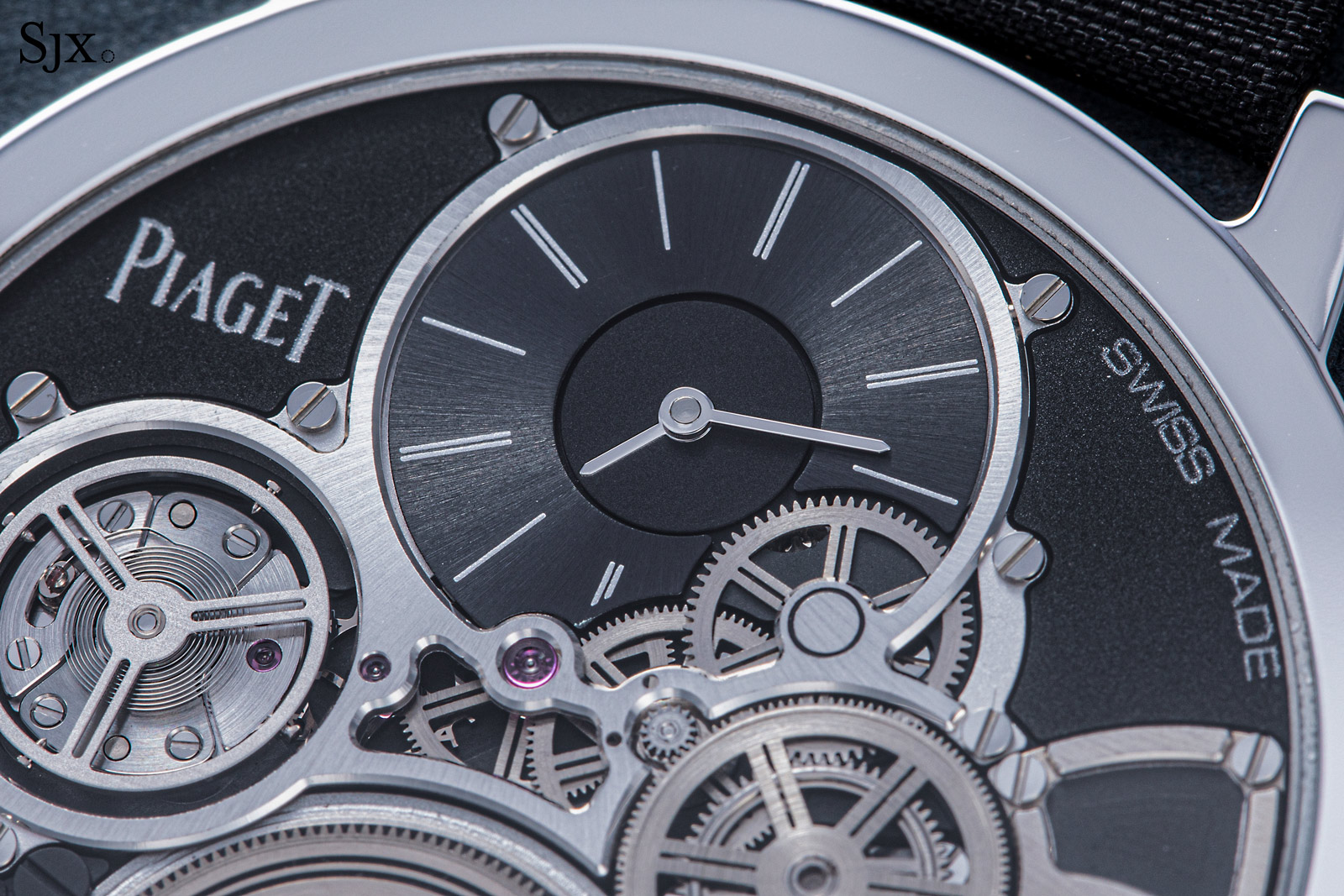
The AUC dial has no room for an hour hand, so it’s replaced with disc with a printed pointer
After the barrel, the components that occupies the most height in a movement are the balance wheel and escapement. In practically every mechanical movement, the balance wheel has a central staff that pivots between the main plate and a balance cock or bridge, even in the 900P.
As a result, the thickness of the movement is constrained by the height of the balance cock or bridge, regardless of how thin everything else is. So the solution is getting rid of the balance cock entirely, and instead securing the balance only on the side of the main plate in a “hanging” construction.
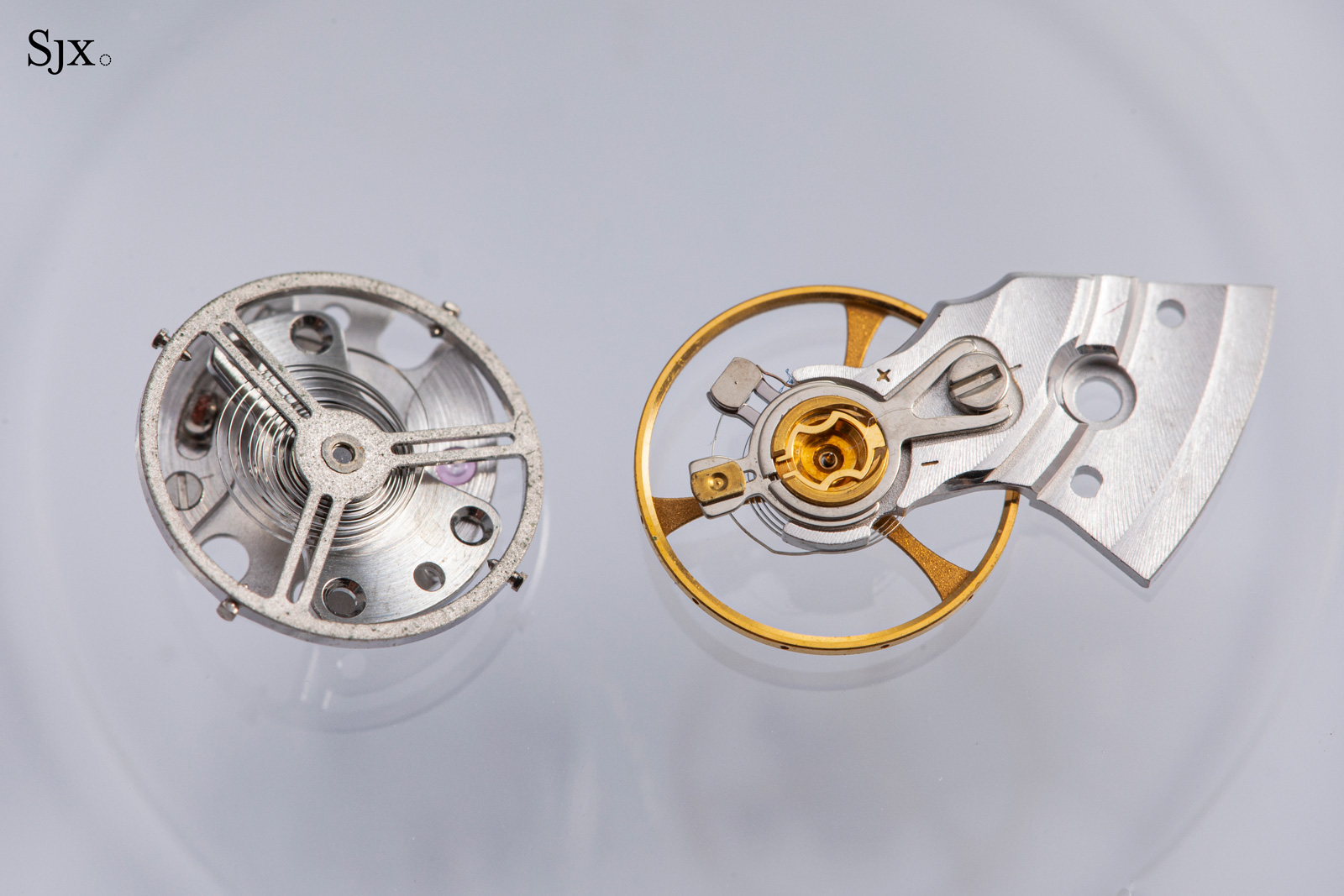
The balance wheel of the AUC (left), and a typical balance wheel on the right – both balances are similar in diameter, but the AUC’s balance assembly is far more compact
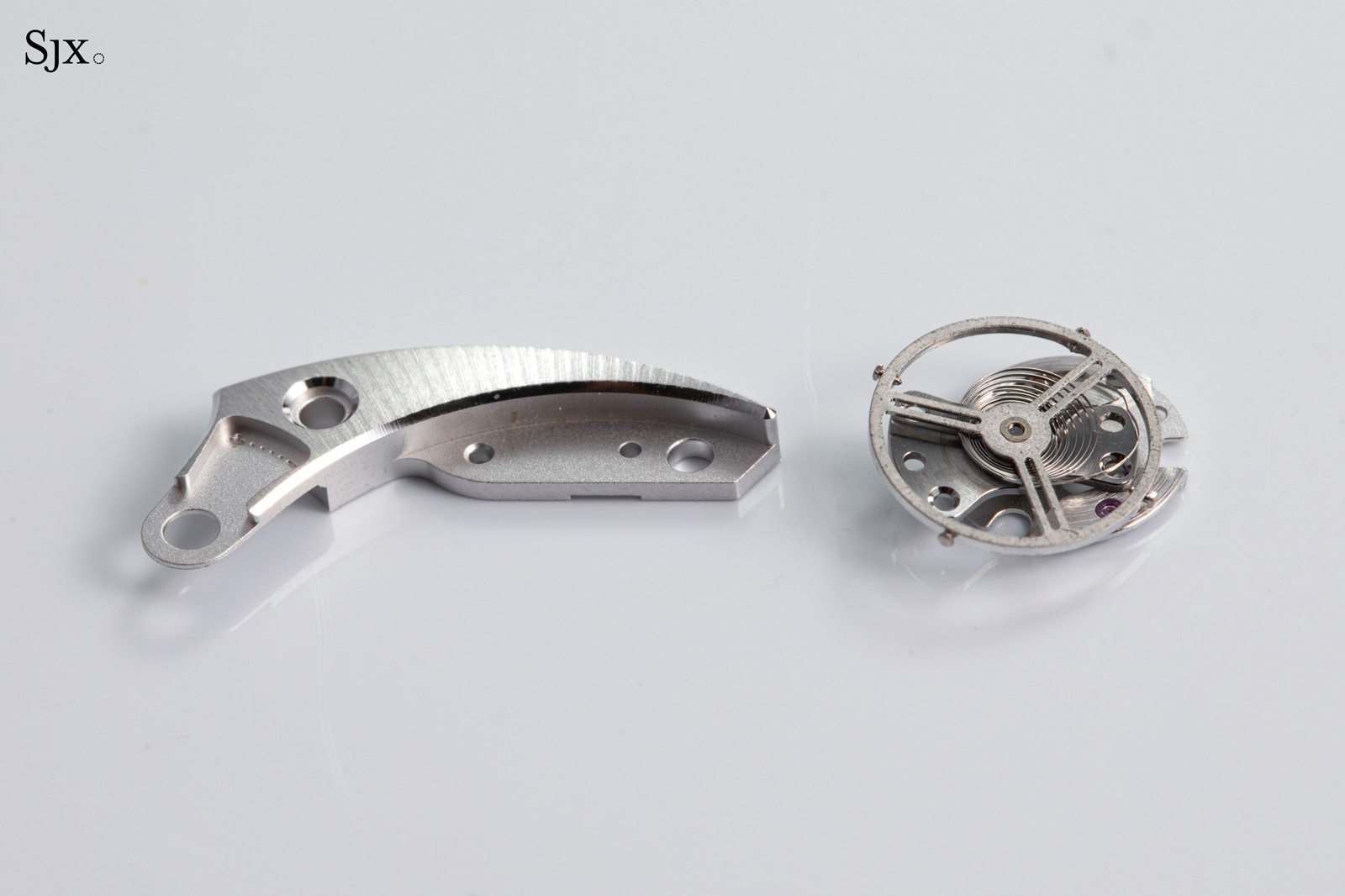
The balance cock of the 910P (left), versus the balance wheel assembly of the AUC. Though small, the AUC assembly is complex, with multiple plates under the balance wheel in a complex arrangement – one central plate to hold the balance staff via a ball bearing, and another larger, circular plate as the pallet fork bridge and hairspring stud holder.
The only one of its kind (though JLC did debut a “hanging” tourbillon in 2014 that never seemed to have made it into commercial production), the hanging balance is another vital element in the thinness of the AUC.
Specifically, the balance wheel has a relatively thick central shaft, which serves as the balance staff. The shaft is supported on a ball bearing embedded into the main plate for robustness, replacing the thin balance staff pivots in a regular movement.
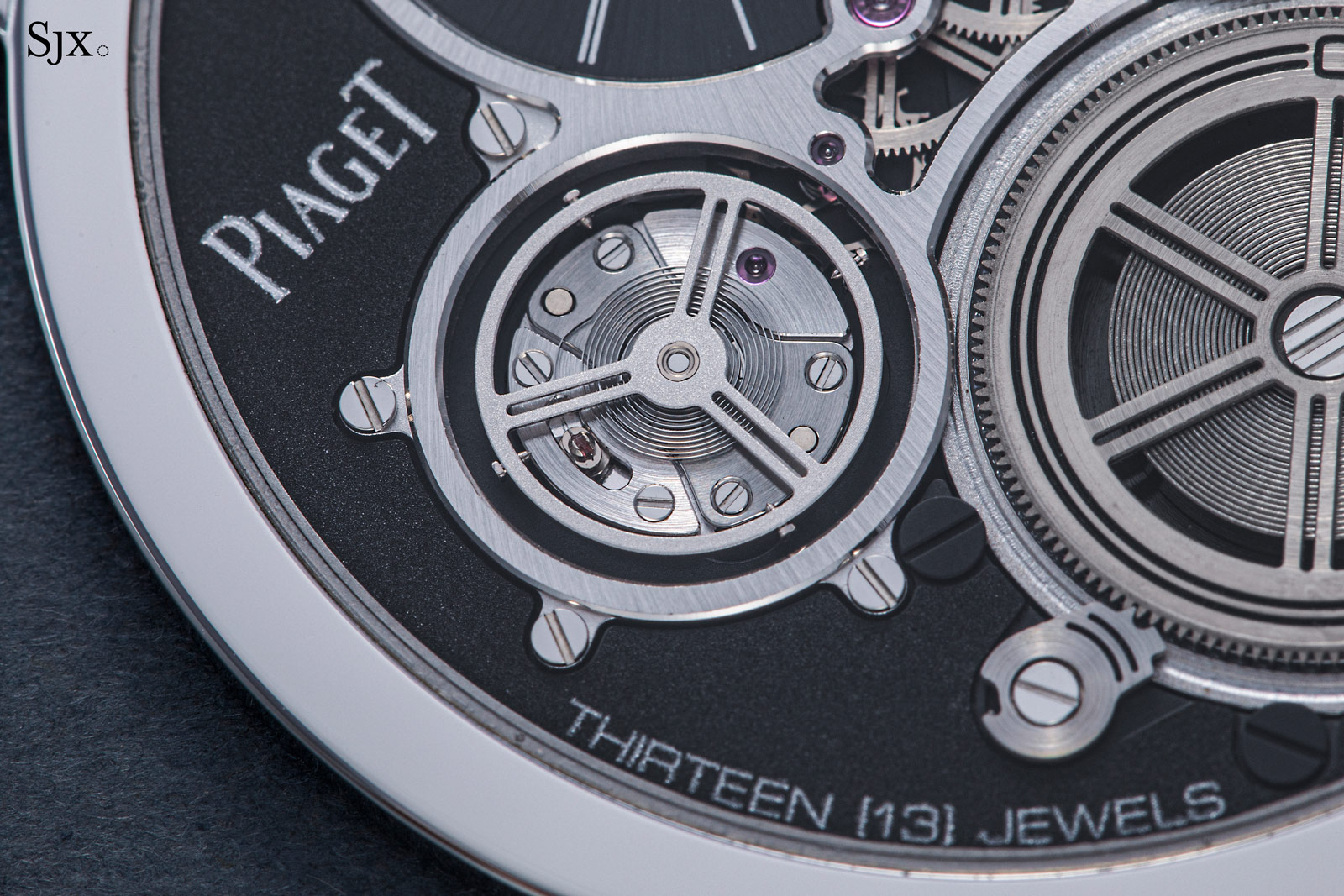
The exposed freesprung balance wheel that is supported by a thick, central shaft
This leads to some interesting design features – first, the larger pivot and ball bearing eliminates the need for shock absorbers on the ends of the balance wheel shaft, which would have added further thickness dictated by the pivot and cap jewels.
Also, since there is no longer a balance cock, the hairspring has no attachment point. Thus, the hairspring is inverted – it sits under the balance wheel rather than above it, and the hairspring stud is fastened to the pallet fork bridge instead.
As a consequence of the balance construction, it would be difficult, if not impossible, to adjust timekeeping if ordinary regulator pins were used, since there is barely any space between the balance wheel and the pallet fork bridge underneath. Therefore, the logical choice was a free sprung balance, with four inertial screws on its rim that can be adjusted to regulate its rate.
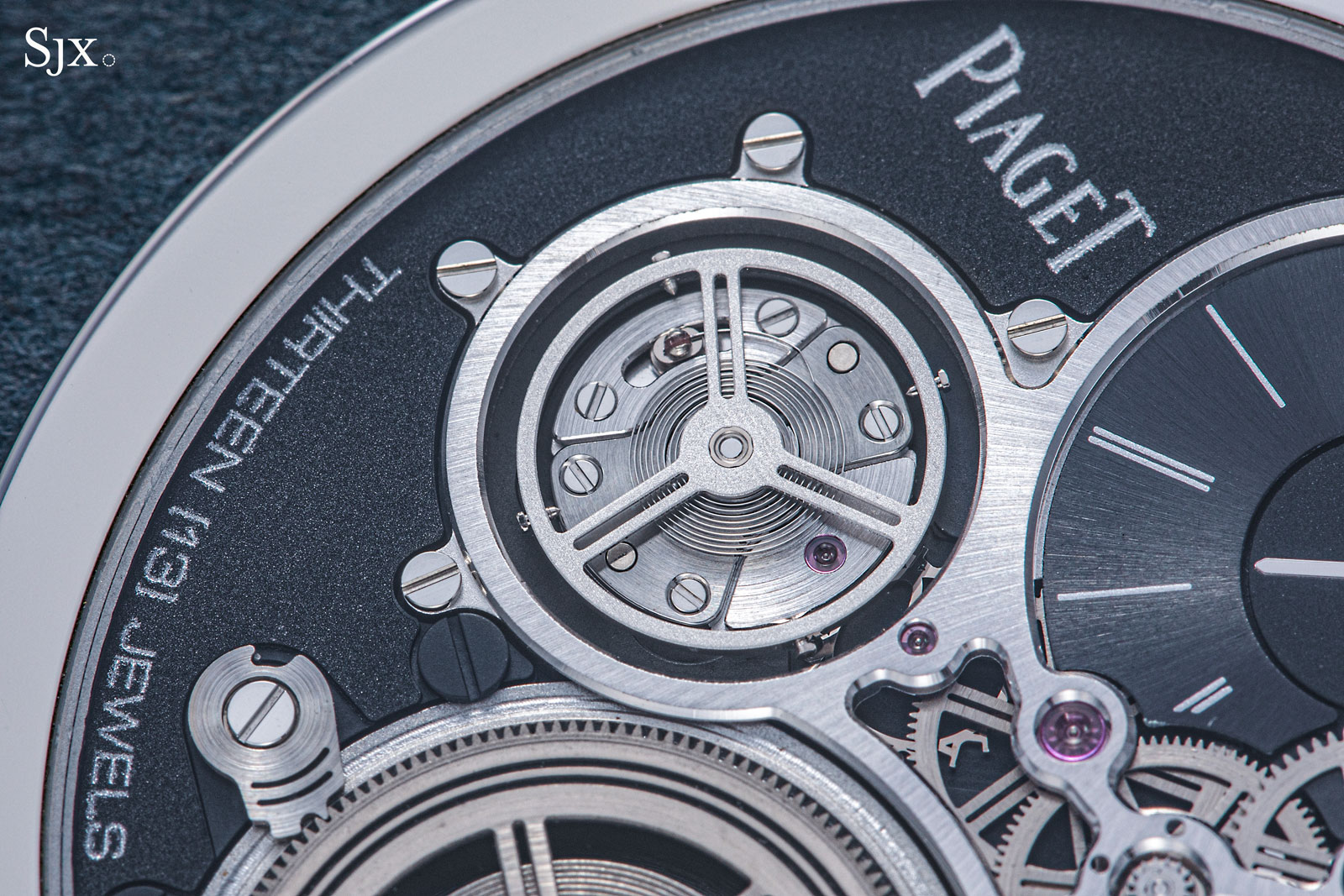
The AUC has an exposed, “floating” balance wheel, supported by a ball bearing hidden underneath
One drawback of the construction, however, is timekeeping – the set up made it difficult to precisely monitor the performance of the oscillator. Conventional timing machines analyse the sound of the escapement with a highly-sensitive mic that picks up the ticks and tocks of the pallet lever and escape wheel, but the interference created by motion of the ball bearings in the AUC movement make acoustic measurement imprecise.
While Piaget has not disclosed how it times the AUC’s performance, it was likely done with high-speed camera that measures either the balance wheel’s oscillation or the position of the hands on the dial over time, or perhaps both.
Ultimately, the AUC is regulated to within -5/+15 seconds a day, a wider range than the chronometric standards like COSC, but one that’s understandable given the technical restrictions of its ultra-thin construction.
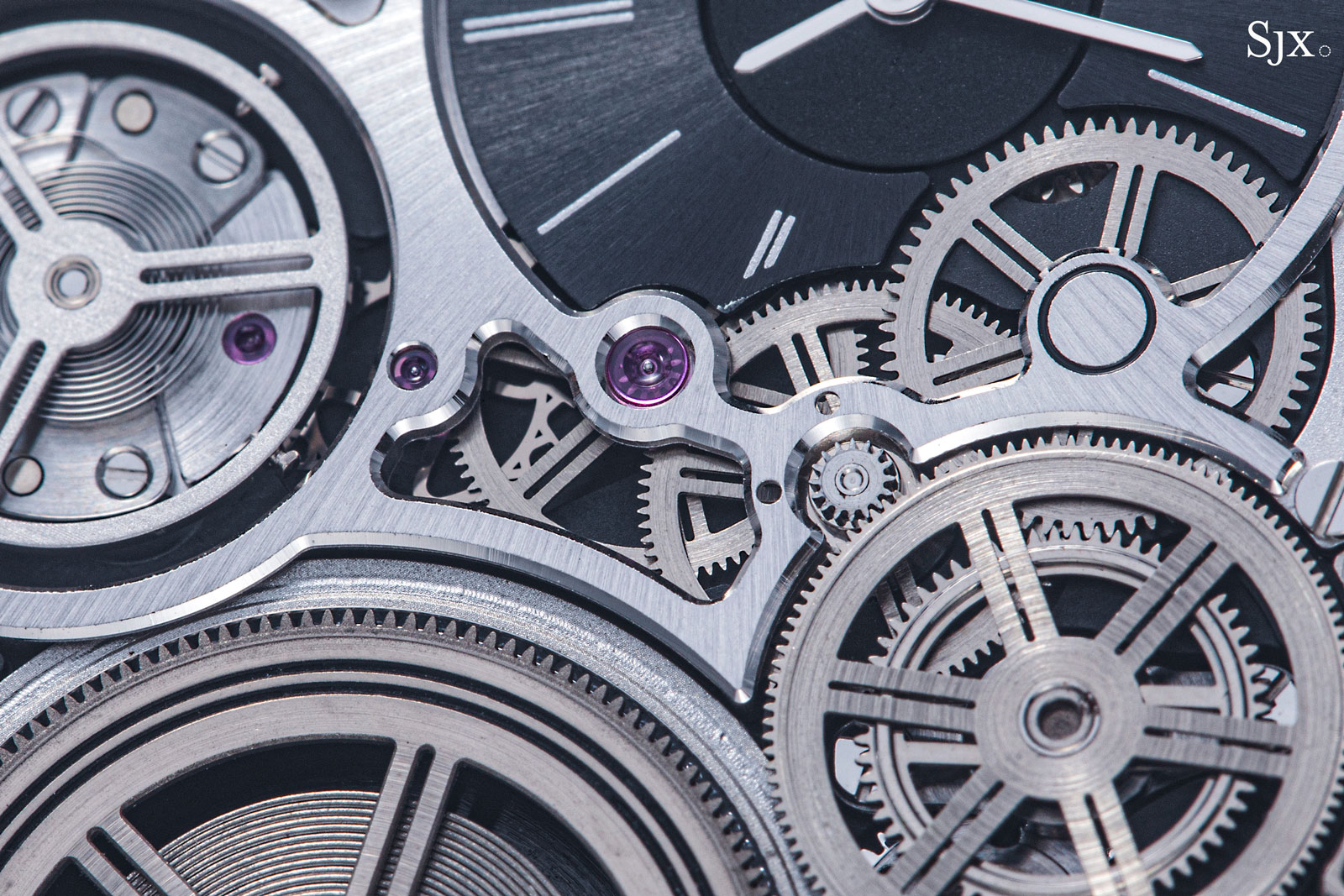
The fourth wheel supported by a large jewel bearing. Interestingly, a seconds hand could have been mounted on this wheel, but with a few caveats – because the movement is face-up on the dial, so a seconds hand would rotate counter-clockwise, and the more obvious constraint is lack of vertical space, not to mention the strange aesthetics of a constant seconds hand
Crowns, crystals, and kevlar
Another challenge in the ultra-thin construction of the AUC – and one easily overlooked because it’s so obvious – is the crown.
Taken for granted in regular watches, the crown evidently must be equally diminutive in an ultra-thin watch. Already in the 900P, the crown is conventionally round, but tiny.
A round crown would be thoroughly impractical on the AUC, since the crown would need to be slightly under 2 mm in diameter, making it impossible to grip. The AUC instead relies on a relatively long rectangular knob integrated into the case.
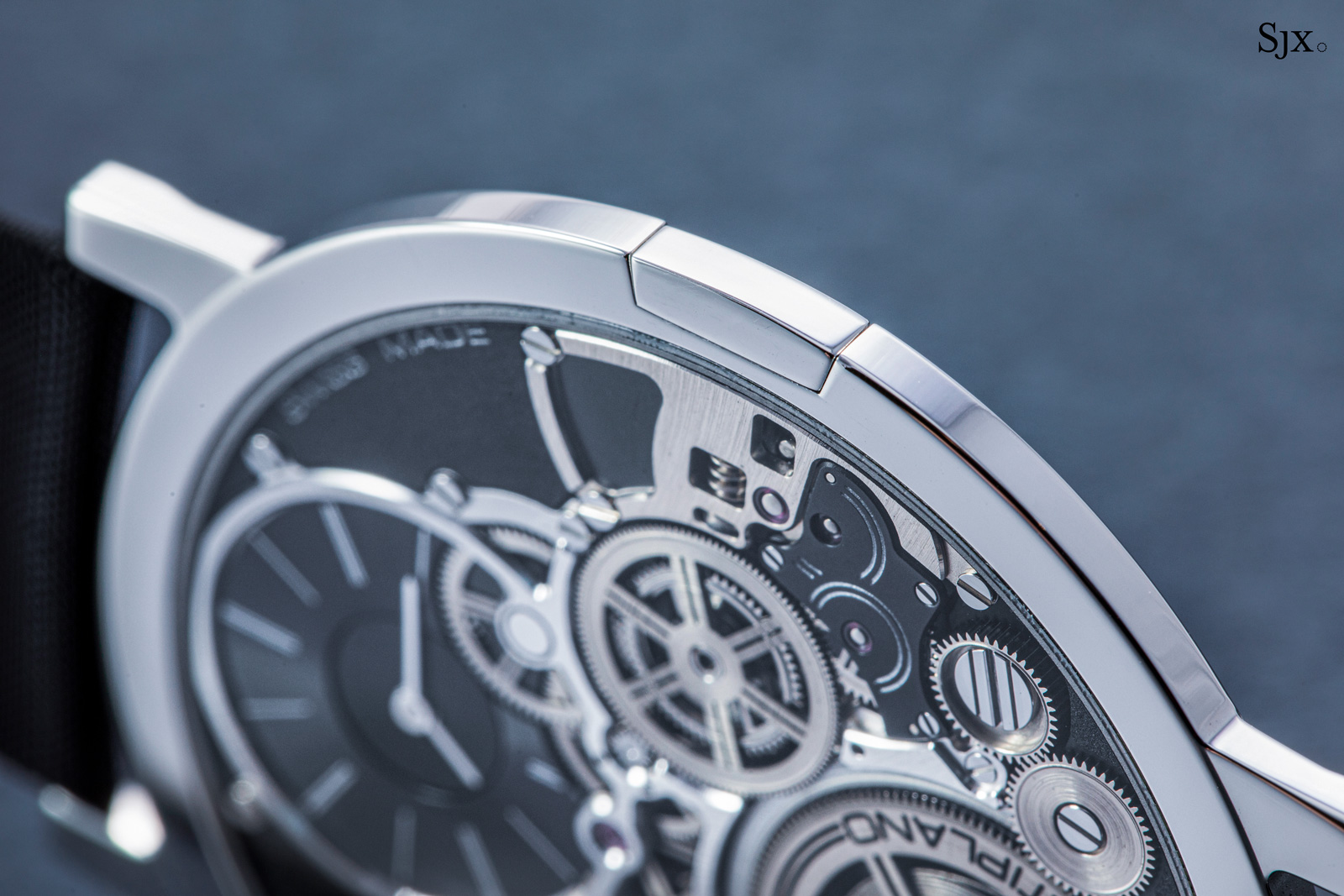
The crown slots into the case when not in use
While the crown is the more tangible aspect, a bigger challenge lay with the keyless works. Typically, a keyless works relies on a clutch and winding pinion, driven directly by the stem, that are perpendicular to the dial. In that set up, the winding pinion engages the crown wheel (which in turn winds the barrel), requiring yet another layer of vertical space in the movement. Cumulatively, this easily exceeds the 2 mm height limit of the AUC.
Thus a worm gear – dubbed an “infinite screw” by Piaget – was used instead. This allows the gears to mate laterally on the same plane as the movement plate, while staying within the allotted 2 mm height.
The worm gear also has a mechanical advantage: it has a high reduction ratio, which means that more torque can be applied to wind the mainspring barrel. That, however, means more turns of the crown are needed to wind the barrel fully – Piaget acknowledges winding the watch by hand is possible but tedious, explaining the special tool that accompanies the watch to assist winding.
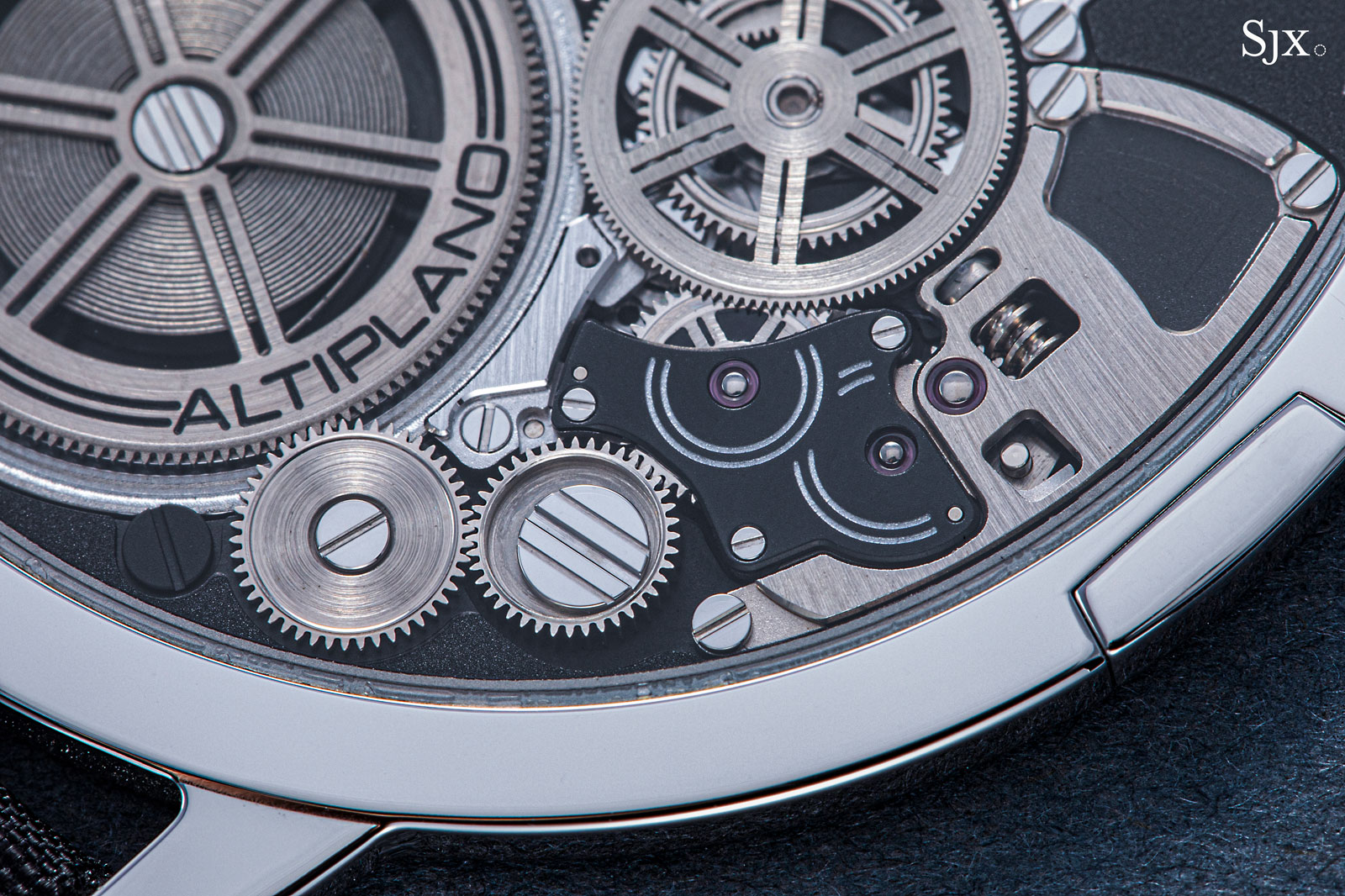
The “infinite screw” on the right that drives the keyless works wheels sideways on the same plane, preserving thinness
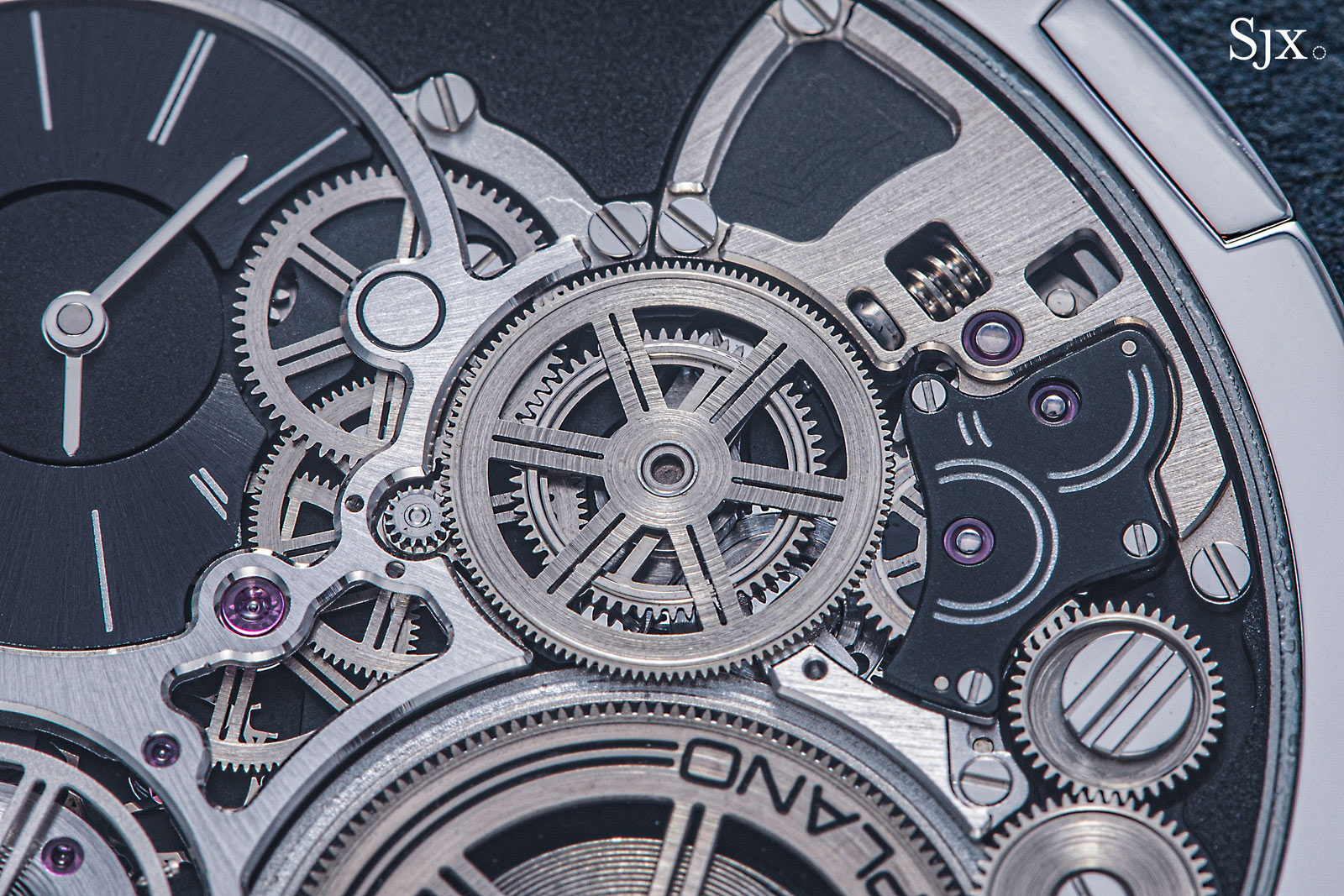
The series of wheels that drives the time display is visible above left, and also allows for time setting via the crown
Despite its unusual mechanism, the crown functions like that in a watch with regular keyless works – it winds in the first position and pulling it out all the way allows for time setting. It is a convenience that makes a radical watch fairly user friendly.
That said, the development team behind the AUC considered to separate winding and time setting into two crowns – a swift, simple solution – but decided against the shortcut.
Since the entire height of the watch is 2 mm, with the majority of that occupied by the movement, there is barely any space left for the crystal. More precisely, there’s 0.2 mm left for an ultra-thin sapphire crystal – almost as thin as a human hair.
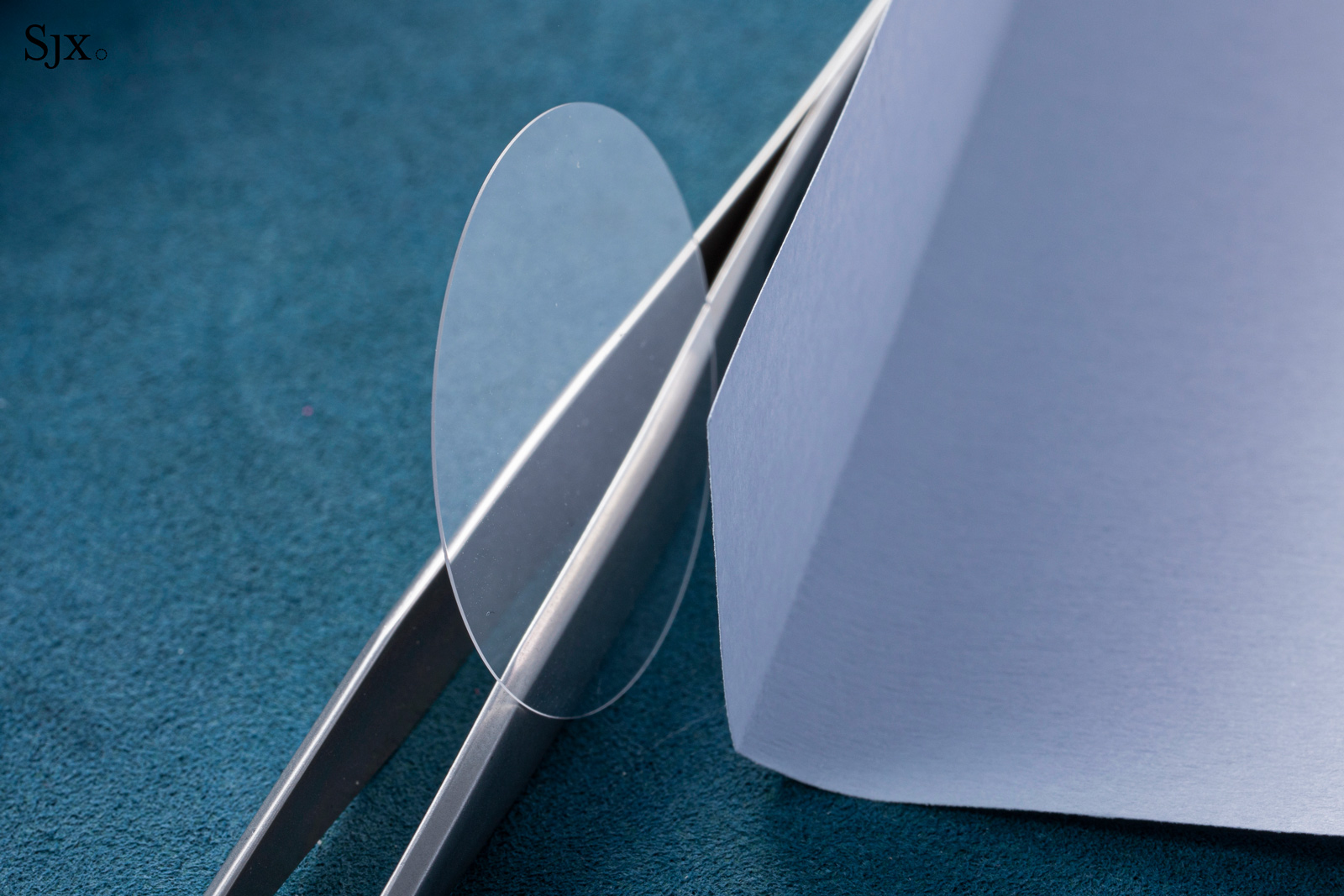
The 0.2 mm sapphire crystal in the AUC
Due to its thinness, the crystal is prone to flexing if pressed on its front, which could result in the underside of the crystal touching the wheels of the movement and stopping it.
To protect the wheels, the movement’s bridges have raised lips around the apertures for the moving parts, which prevent the crystal from touching key components such as the balance wheel and hands.
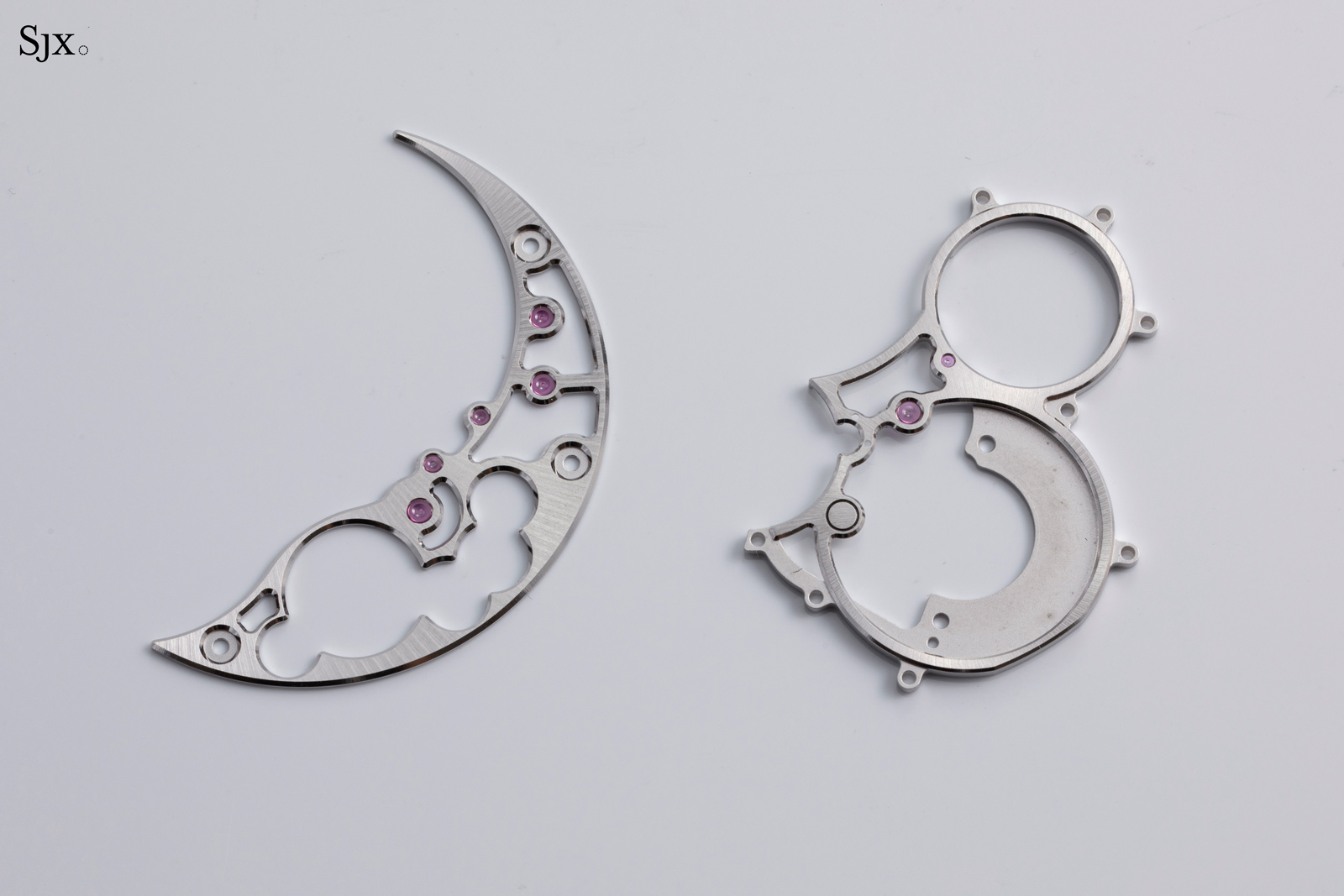
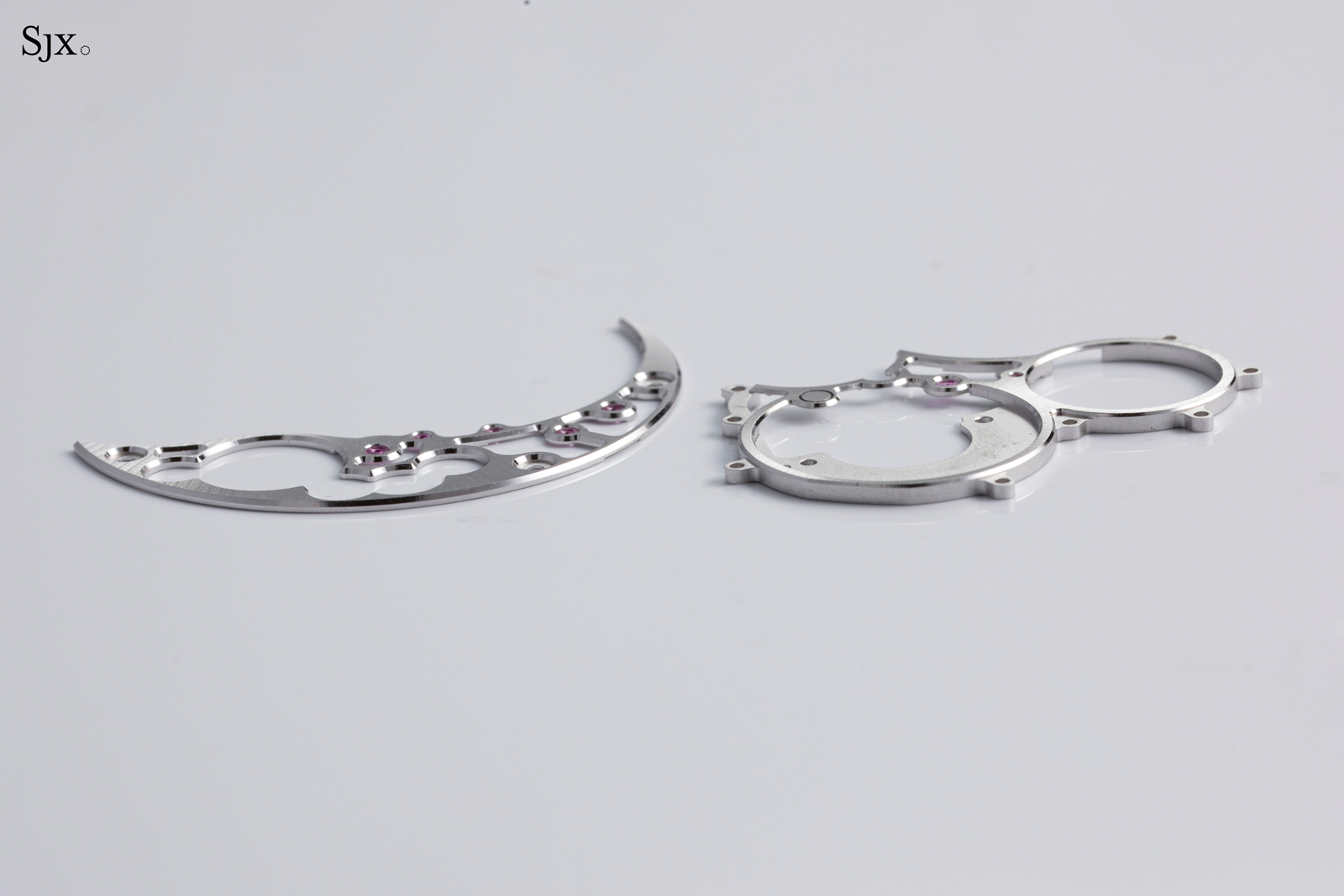
The movement bridge of the 910P (left), that of the AUC that has two rings encircling the dial and balance wheel, providing support to the sapphire crystal in case it flexes inwards when pressed on
While not as crucial as the watch itself, the strap was also an important consideration. Piaget experimented with straps as thin as 1.1 mm that were made of alligator leather wrapped around a Kevlar core. The paper-thin straps were deemed awkward both in comfort and appearance, and the straps on the production examples were bulked up to match the case thickness of 2mm.
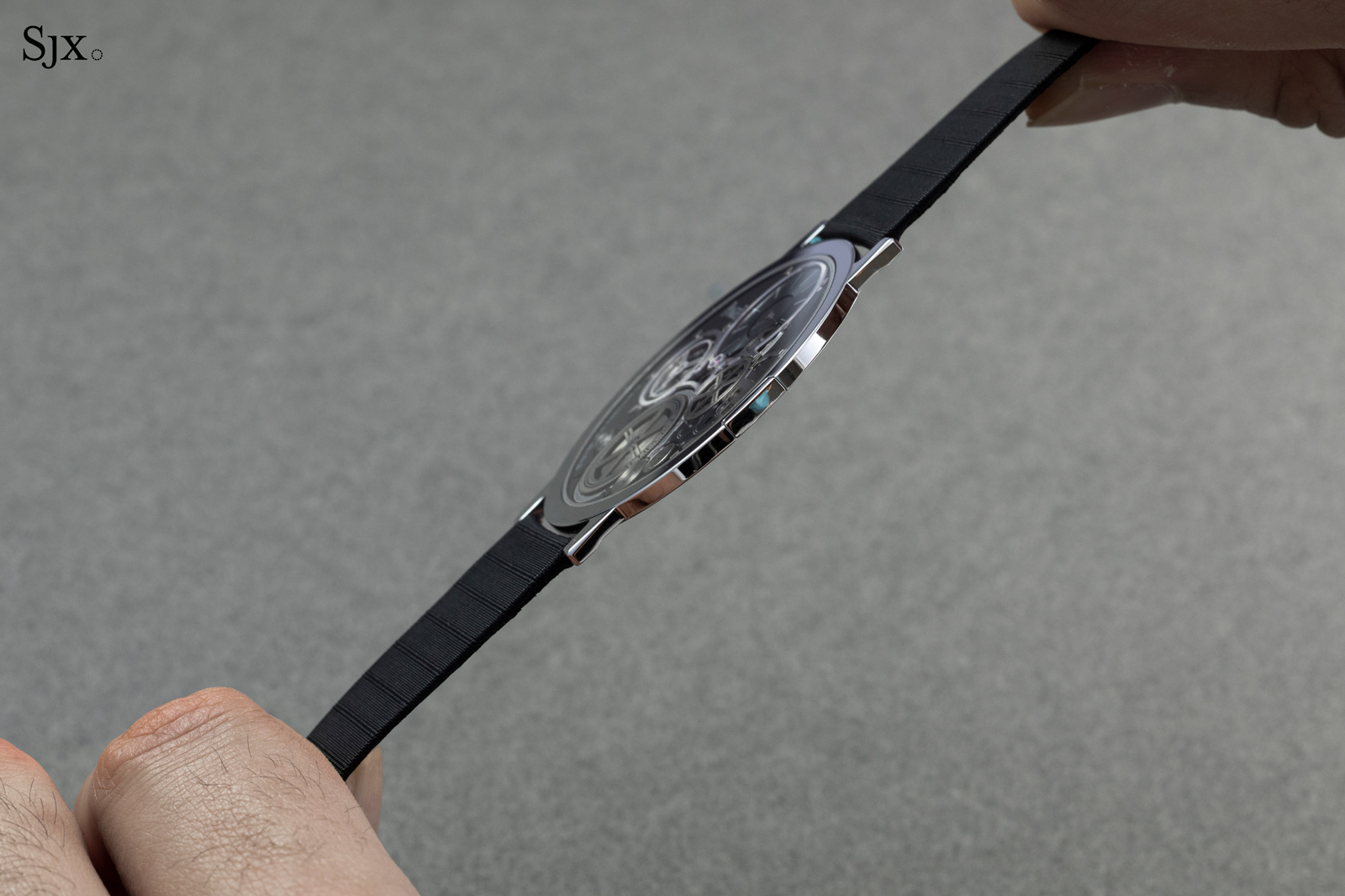
The ghost of Jean Lassale
As an aside, the widespread use of ball bearings in the 900P-UC is worth a digression.
The movement’s developers cited as inspiration the now-defunct brand Jean Lassale, which was behind the thinnest-ever mechanical movement – the cal. 1200 that was a staggering 1.2 mm thick – accomplished way back in 1976 when the brand made its debut. Measuring a bit over 3 mm as a completed watch, the Jean Lassale 1200 was realised only with extensive use of ball bearings for most of the wheels.
Unfortunately, the cal. 1200 was extremely unreliable; it would stop working even when wearing the watch too tightly on the wrist, which caused the slightest bend of the case. And not to mention servicing was next to impossible, except by specialised watchmakers.
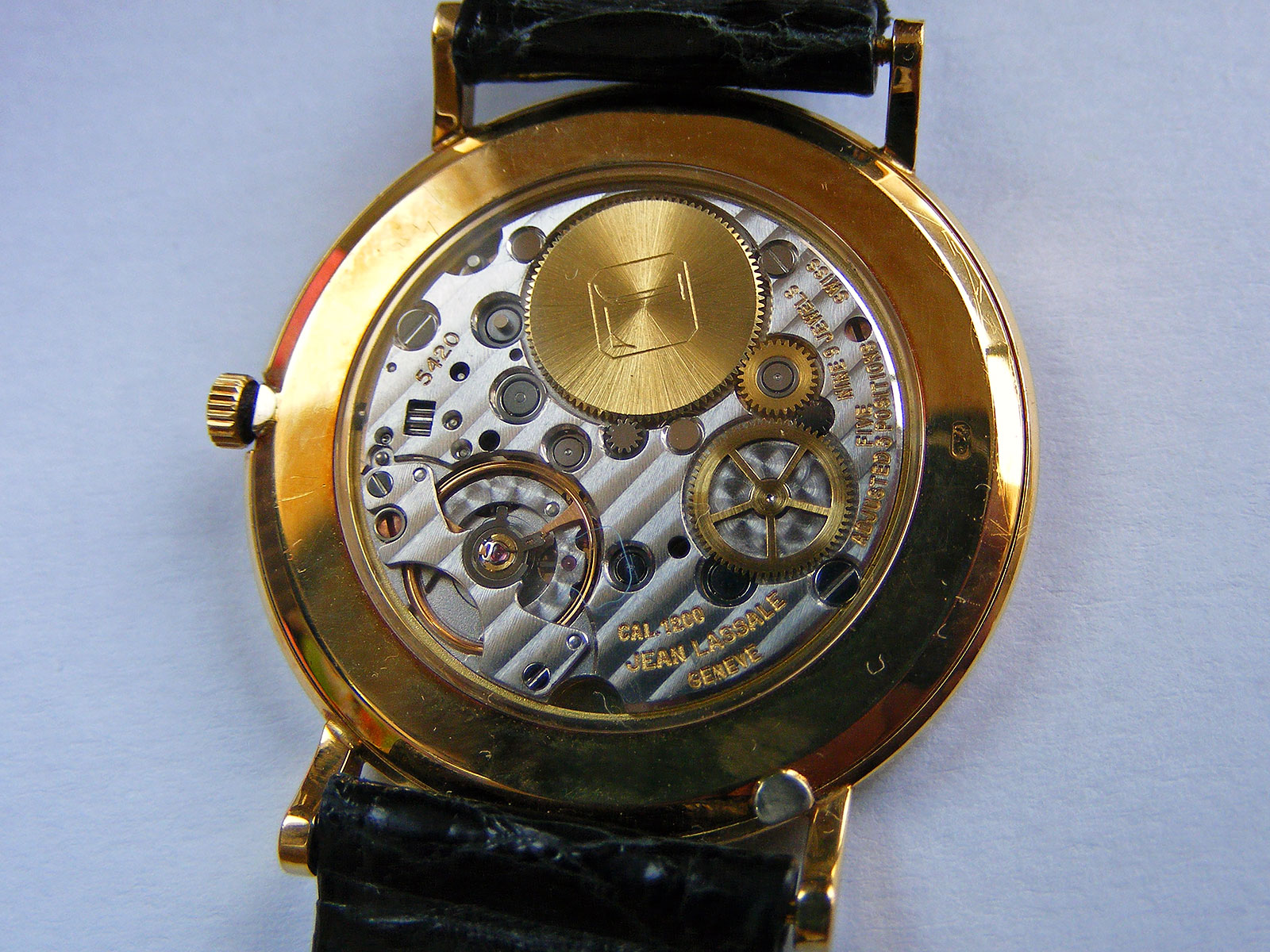
The brilliant but unlamented Jean Lassale cal. 1200. Image – Jjcasalo
Beyond its delicate watches, Jean Lassale also arrived on the market right smack in the middle of the Quartz Crisis. Unsurprisingly, the brand went bust in 1979.
The company’s patents were acquired by Claude Burkhalter, who helped establish Nouvelle Lemania in 1981 when the movement maker was spun off from its parent. Lemania in turn licensed Jean Lassale’s intellectual property, namely movement constructions and patents, to Piaget, forming the foundation of Piaget’s ultra-thin movement hall of fame.
The Jean Lassale brand name, on the other hand, was acquired by Seiko, which applied it to a range of high-end, ultra-thin quartz watches, which was also a short-lived venture. Today Seiko brands its top-of-the-line watches Credor or Grand Seiko.
Ultimately, the progress of the ultra-thin watch can be categorised into three stages: the beginnings four decades ago characterised by cutting-edge mechanics and poor reliability, as exemplified by Jean Lassale, followed by reliability in the contemporary watches of the 2000s, but with increased thickness as seen on the Altiplano 900P.
And that culminates in the third – and perhaps final – chapter, with the AUC that blends both cutting-edge engineering and reliable functionality.
Conclusion
The Piaget AUC might be the final frontier in terms of how thin a mechanical wristwatch can be, while still being useable and commercially viable. While it may be theoretically possible to go thinner, it would either require non-traditional materials, or massive compromises that result in severe reliability issues.
Piaget’s achievement does comes at a steep cost – 400,000 Swiss francs – for what’s essentially a time-only watch is hard to digest. The marginal returns rapidly diminish as the watches thins – the AUC is half the thickness of the Altiplano 900P, but over 15 times more expensive.
However, the enthusiast who collects undisputed absolutes need wait no longer, as the AUC is an accomplishment that will remain uncontested for a long, long time.
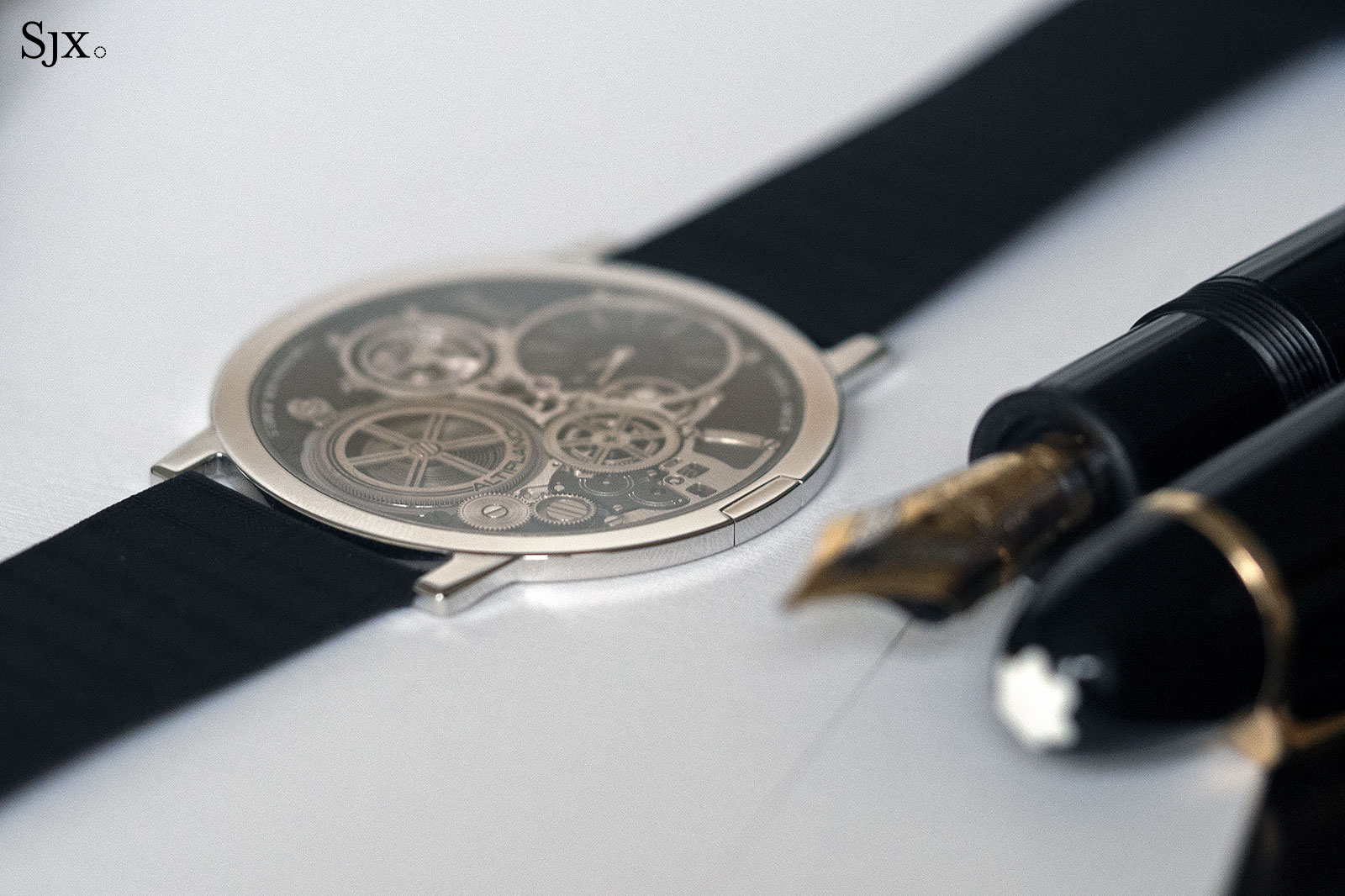
Key facts and price
Piaget Altiplano Ultimate Concept
Ref. G0A45500 (and variants)
Diameter: 41 mm
Height: 2 mm
Material: Cobalt alloy
Crystal: Sapphire
Water resistance: 20 m
Movement: 900P-UC
Functions: Hours and minutes
Frequency: 28,800 beats per hour (4 Hz)
Winding: Hand-wound
Power reserve: 40 hours
Strap: Various, including leather, rubber, and fabric
Limited edition: Custom order
Availability: Now at boutiques
Price: Starting from about 400,000 Swiss francs
For more information, visit Piaget.com.
Back to top.